Today, they’re helping Fordham build its own.
When they learned about the waterfront center that Fordham is planning, “it was something that we felt really strongly that we’d like to be able to help create,” Laura Ekholm said.
They’re doing just that with a major gift toward the project, for reasons that have a lot to do with their children’s experience at Fordham.
Support for Sailing and Other Aquatic Sports
The waterfront center will be built on Eastchester Bay in the Bronx, four miles east of the Rose Hill campus, to serve the varsity women’s rowing team as well as men’s crew, co-ed sailing, and women’s sailing. The first phase, construction of docks, is expected to be completed in time for the fall 2024 season.
Fordham donors and supporters have been moving the project along for years, led by Fordham Trustee Fellow Dennis Ruppel, FCRH ’68, and his wife, Patricia Ann Ruppel, who are making another major gift to the project this year. In October, Fordham Trustee Kim Bepler hosted and underwrote a fundraising dinner for the project at the New York Yacht Club in Manhattan.
The event raised $1.3 million for the project—with $1 million of that coming from the Ekholms.
‘Something of Great Value’
The Ekholms raised their family on Minnesota’s Lake Minnetonka, and their children grew up sailing on it, so when two of them—Anders, FCRH ’17, and Annika, FCRH ’20—went to Fordham, it was no surprise that they signed up for sailing.
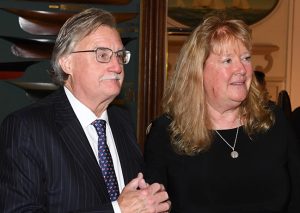
They were impressed at the strength of the classroom education their children received, as well as the tight-knit sense of community in the sailing program and its rigors that hone time management and other life skills.
Today, Anders Ekholm is a team lead with TransPerfect, a translation and language services company in New York, and Annika Ekholm is involved with the sailing program full time. In addition to volunteering as a coach, she works for the Fordham Sailing Association, helping to set up a community sailing program in conjunction with the Villa Maria Academy, a Catholic elementary school next door to the waterfront center’s site.
She’s excited to see how the center could support other programs for area youth as well. “Sailing has given me and so many other people in the Fordham sailing sphere so much,” she said, “and anything that we can do to spread that, to give that to the community, will be a great, great thing for all involved.”
Being involved with the sailing program has been “a ton of fun,” Laura Ekholm said. “It’s just a fabulous community.”
She and Paul are investing in the waterfront center not only because of its immediate benefits but also to advance the University generally. “Giving money away is something to do when you find something of great value,” Paul Ekholm said. “For me and Laura, the great value of Fordham was the education they got, and we feel like we should support Fordham beyond sending our kids there.”
Gifts in support of the Fordham waterfront center advance the University’s $350 million fundraising campaign, Cura Personalis | For Every Fordham Student. Learn more about the campaign and make a gift.
]]>“We are so delighted to have a new president with such deep and interesting connections within the U.K. and a commitment to continue to develop Fordham’s international impact,” said Fordham London’s senior director, Vanessa Beever, LAW ’94, a University alumna herself. “It’s fantastic to have a fellow female lawyer, mother, and dog owner as our president.”
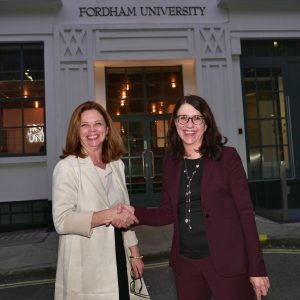
Fordham London opened in 2018. After nearly a decade of borrowing a building from another institution in London, the University signed a long-term lease for a space in the center of the city that it could call its own. The 17,000-square-foot facility has six floors that comprise a lounge, small library, classrooms, and a rooftop terrace that overlooks the trendy Clerkenwell neighborhood. Students from New York can swipe into the London campus with their original ID card. Inside the building, they take business and liberal arts courses that have taken them across the city—to British art museums, theaters, and even fashion shows.
At a presidential alumni reception that also included current students and several Fordham board members and administrators, Tetlow said she’s been hard at work building on the many advantages Fordham offers its students—both in New York and in London.
“In this work of leading Fordham, I get to build on incredible strengths, on our location in the other capital of the world, in New York, and on the chance we have—with our amazing strengths in the humanities, in law, in business, and so much of what we do—to matter to the world, to model for our students what that looks like, to give them opportunities that come from being in New York and also in London,” she said. “To show them the kinds of jobs they can get, the kind of impact they can have on the world, and how they can stretch their imagination about what that looks like.”
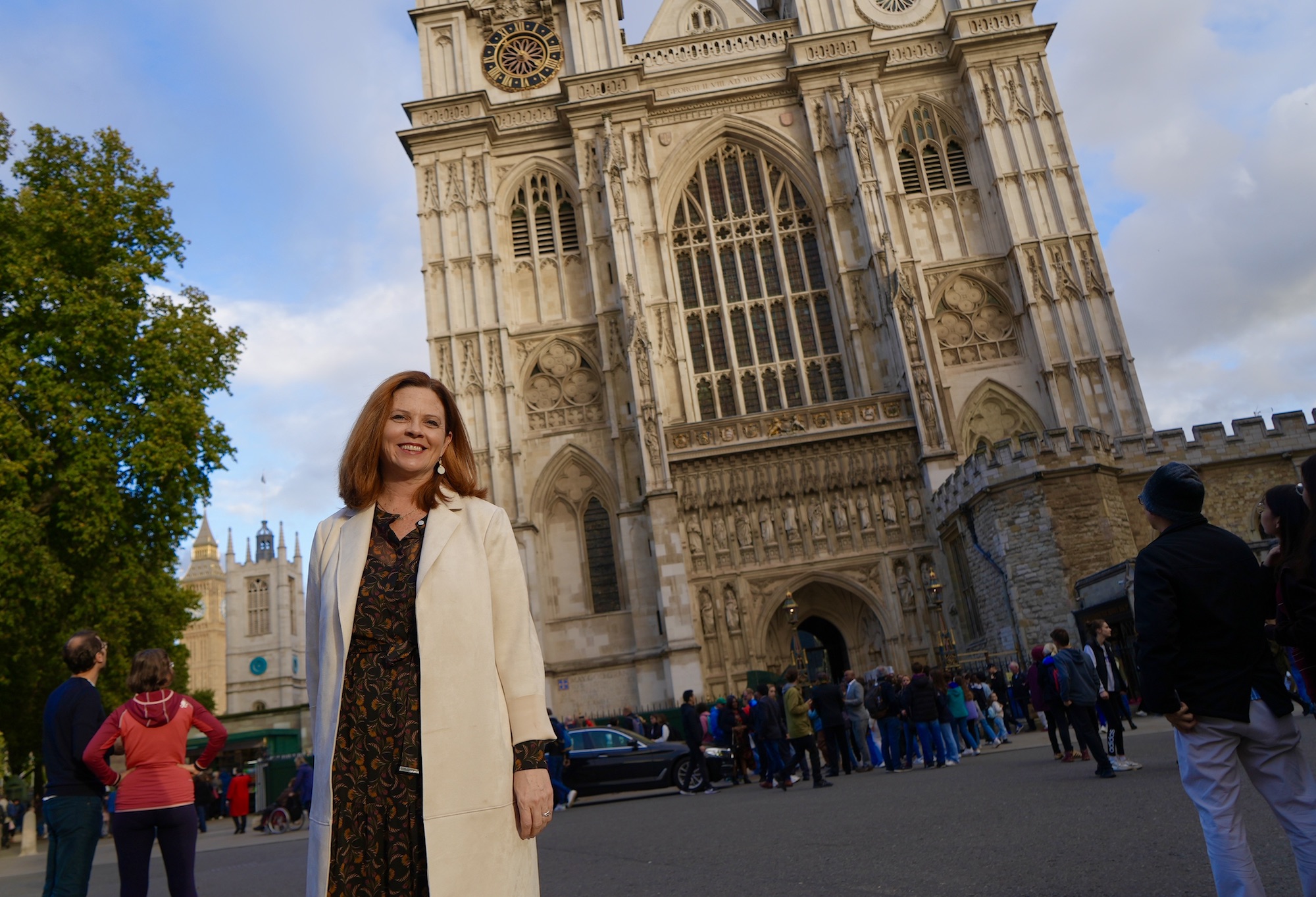
Tetlow’s Longtime Ties to London
Tetlow herself is no stranger to London and the United Kingdom. She is a longtime member of the British-American Project, an organization that promotes cross-cultural understanding among young leaders. Through this group, she made many friends in London and met her husband, Gordon Stewart, who is originally from the United Kingdom. She has a daughter who has American/British dual citizenship; a stepson who lives in Scotland; and a home in Fife, Scotland, with Stewart.
When she first began visiting the United Kingdom, she was surprised by the similarities and nuanced differences between American and British culture, she said. Now, the country—and Fordham’s London campus—feel like home.
“I am proudly bilingual. I drink a cuppa. I take out the rubbish. I feel chuffed from all this praise,” she said at the presidential alumni reception. “And I can, if I’ve had a couple of pints, even understand Geordie. That’s how local I feel.”
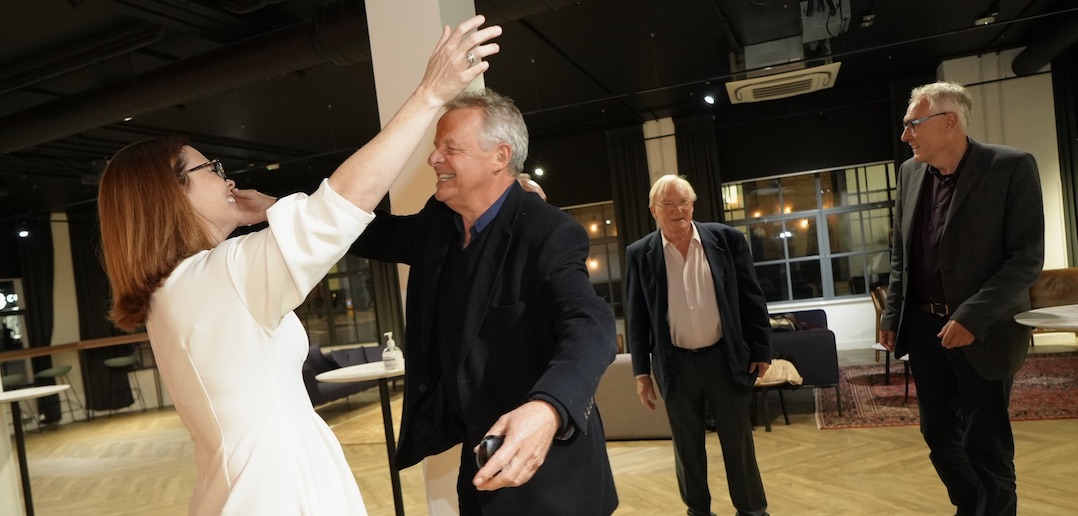
Connecting with the Catholic Church Abroad
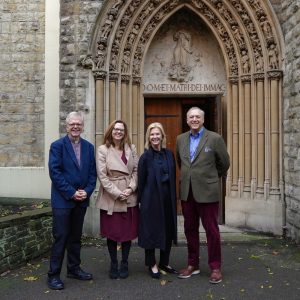 Tetlow’s first trip to London as president of Fordham began with a visit to Westminster Abbey, a historic church that has witnessed coronations and burials for generations of British rulers. As the sun set below the London skyline, Tetlow sat in the same space where recently deceased monarch Queen Elizabeth II had once walked, and observed an evensong performance with colleagues from New York.
Tetlow’s first trip to London as president of Fordham began with a visit to Westminster Abbey, a historic church that has witnessed coronations and burials for generations of British rulers. As the sun set below the London skyline, Tetlow sat in the same space where recently deceased monarch Queen Elizabeth II had once walked, and observed an evensong performance with colleagues from New York.
On Oct. 25, her first full day in London, she attended a morning Mass at Farm Street Church, which has served as the Jesuits’ flagship church in London for nearly two centuries. She was introduced to Michael Holman, S.J., a prior Jesuit provincial of the United Kingdom, who gave her a tour of the sacred space and taught her about the history of London’s Jesuits. (Father Holman has a connection to Fordham, too. In 1989, he earned his master’s in education and administration from the Graduate School of Education and lived at the Rose Hill campus with the Jesuits for several years.)

Meeting Fordham London’s Staff
In the afternoon, Tetlow visited Fordham’s London campus for the first time. Following in the footsteps of her predecessor, Joseph M. McShane, S.J., who last visited Fordham London in 2021, she toured the facilities and met its staff.
Seated at a table with staff, Tetlow inquired about Fordham London. What are the academic programs and curriculum like? Where do the students live? And what are the students themselves like?
Every year, there are about 500 students at Fordham London, she learned, most of whom are upperclassmen from the Gabelli of Business and liberal arts students. The majority are Americans from Fordham’s New York campuses, and they tend to come to Fordham London for a single semester. Students from other American universities studying abroad can also study at Fordham London. Through connections with study abroad housing partners, students are able to live in local apartments that offer a glimpse of post-graduate living. They commute to campus by taking the Tube, riding a red double-decker bus, or simply using their own two feet.
Through partnerships with local universities, students are able to take one or two courses outside the campus, at the City University of London and other schools. But the bulk of their education takes place at Fordham. Through their faculty and coursework, liberal arts students have been able to perform in the iconic Tower of London and view versions of Shakespeare’s plays that appeal to a modern audience. Through school-sponsored trips, students from all disciplines travel across the United Kingdom to famous sites like Stonehenge. (They also use their free time to explore the whole European continent, including Paris, which is no more than three hours away by train.) And just outside the Fordham London campus is Leather Lane, a bustling food market that stretches across several streets and boasts a wide selection of cuisines, from Persian kebabs to Japanese hibachi to Yorkshire burritos—pudding wraps with sage stuffing, spinach, roast potatoes, and gravy.
Armando Nuñez Jr., chair-elect of Fordham’s Board of Trustees, attended the meeting with Tetlow and Fordham London staff.
“It’s so wonderful to be here in person with our new president and to be engaged in this conversation,” said Nuñez. “The University has a great opportunity here to expand its global footprint in a smart and strategic way.”
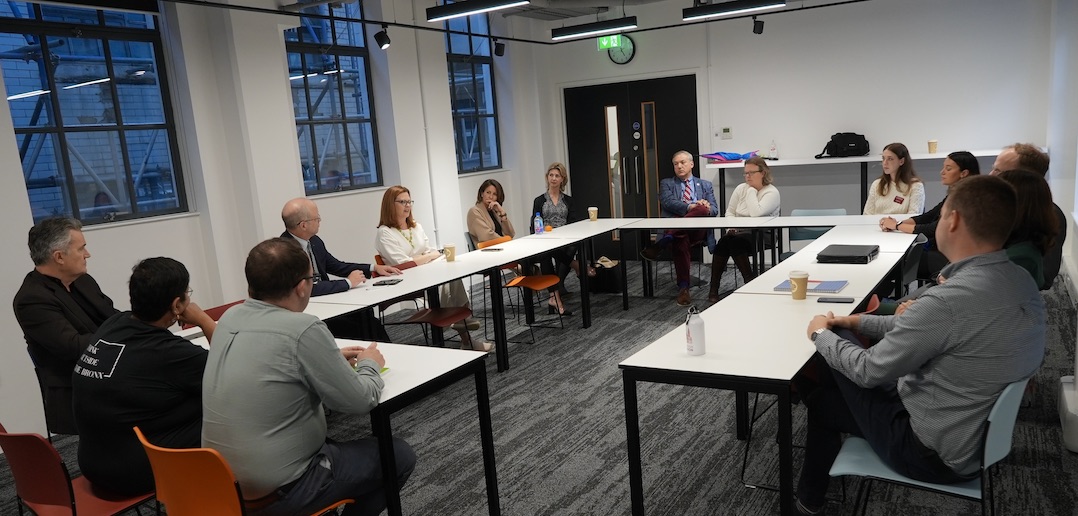
After the meeting, Tetlow hosted a reception for the British-American Project at Fordham London. The next day, she welcomed more than 100 members of the Fordham family at the presidential alumni reception held in the Shard, the tallest building in Western Europe. And in private meetings paired with food and wine throughout her trip, she became acquainted with alumni who now call London home.
William J. Loschert, GABELLI ’61, is a trustee fellow who grew up in Queens, New York, and now lives in London.
“Fordham London is a great hub for students,” Loschert said. “London has a lot more traditional history than New York. We also have a different form of government, which right now is kind of a mess with three prime ministers in two months, but it’s a different culture, and I think it’s good that students can get out of New York and America and see how the rest of the world lives.”
On Thursday—Tetlow’s final day in London—she met with the Fordham London Advisory Board and other senior members of the University’s administration to brainstorm ways to improve the study abroad experience for students; she also met Fordham London’s new head of experiential learning. At an evening reception held on campus, she was introduced to Archbishop Claudio Gugerotti, the apostolic nuncio to Great Britain.
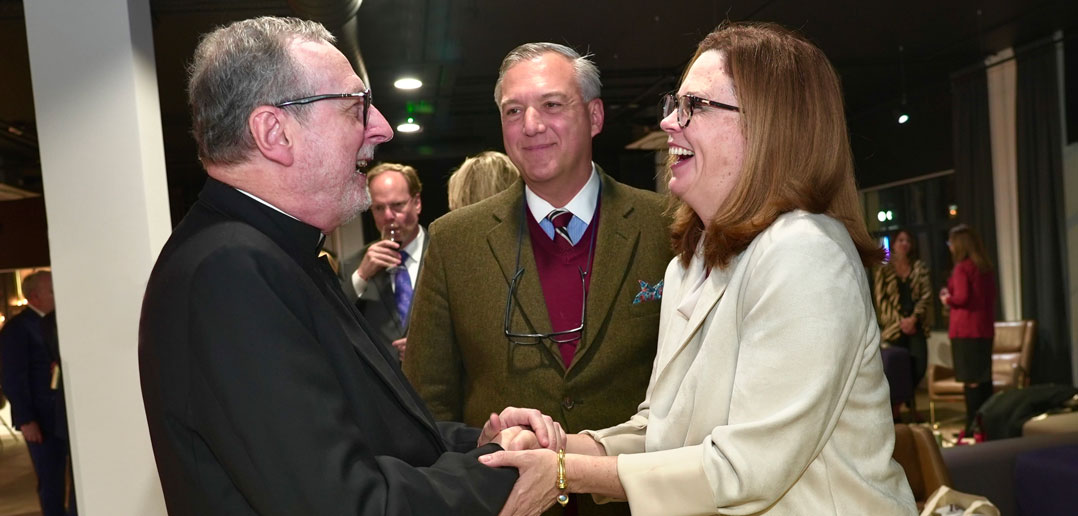
A Luncheon with the ‘Future Generation of Fordham Leaders’
Finally, she ate lunch with visiting Gabelli School of Business students in Fordham London’s ground floor lounge. The students, who study in the Professional MBA Program, had flown to London as part of their course called The Tale of Two (Global) Cities. For one week, they studied the differences between American and British businesses through lectures, walking tours, and site visits at places like Goldman Sachs, Mercer, and TrueLayer.
In attendance at the luncheon was Andrea Mennillo, Ph.D., chair of Fordham London’s Advisory Board, who thanked the business students for coming to the London campus.
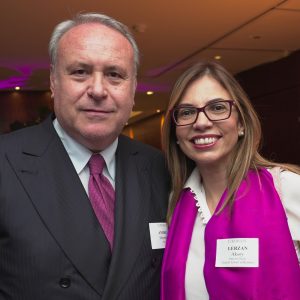
“At this table are my fellow members of the board,” he said, gesturing to his colleagues in the room. “We are available to help—to advise, to consult—because you are the future generation of Fordham leaders.”
The students introduced themselves to Tetlow and the senior members of Fordham’s administration. Most of the students are in their final year in the MBA program and already hold jobs at prestigious companies, including Warner Bros, Forbes, The Wall Street Journal, and JPMorgan Chase. They work in a variety of industries, including advertising, fashion, law, cybersecurity, health care, media, investment relations, and private equity.
Tetlow told the students she was glad their business education at Fordham could include this international perspective.
“This is an amazing city, and I bet a lot of you have gotten a taste of it and want to come back,” Tetlow said to the students. “So I’m glad, especially to those of you who are here just for a week, that you’re digging in, really listening hard, asking good questions, and learning in ways that will change your thinking forever.”
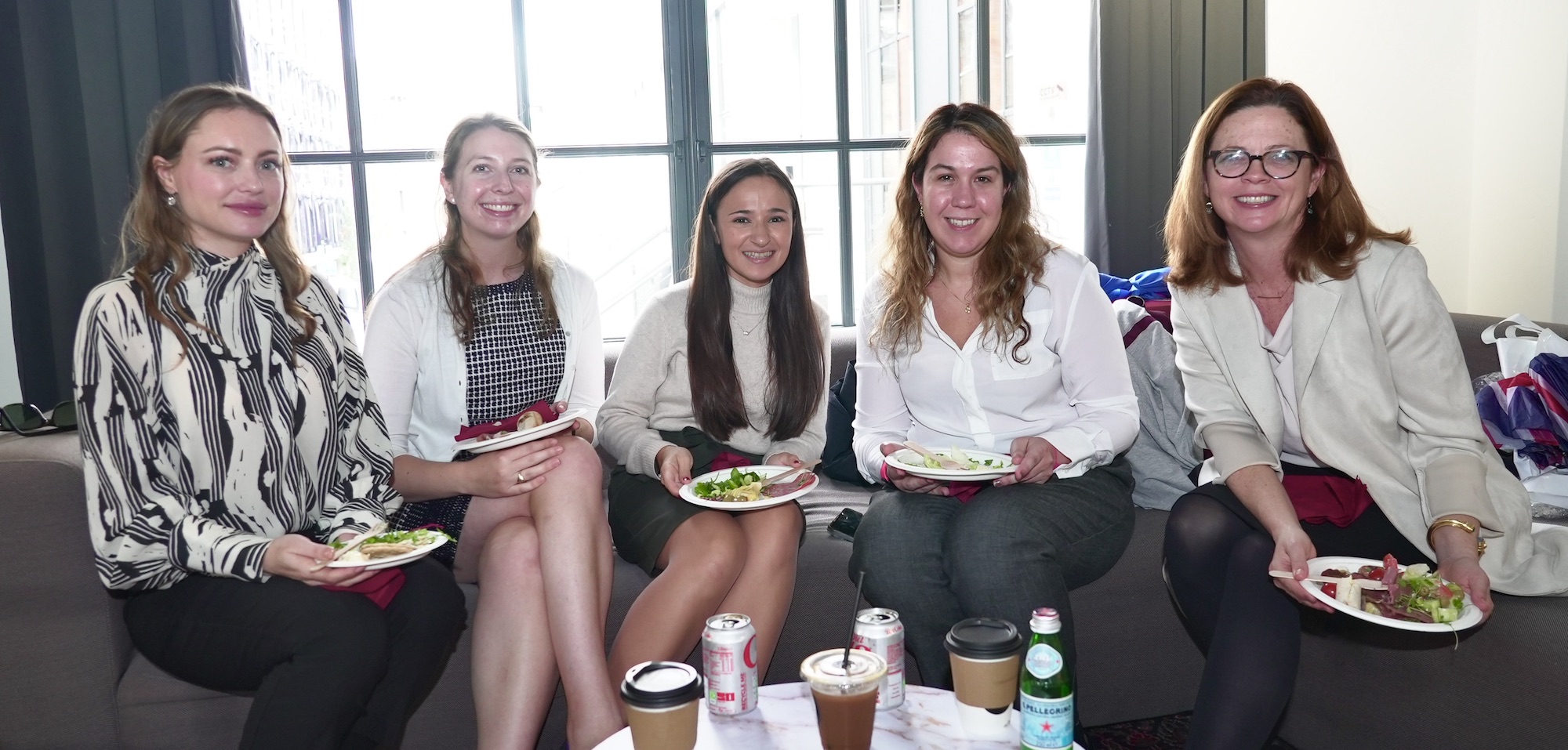
This year’s Pioneering Women have enhanced all areas of the University, from endowed faculty chairs and student scholarships to community engagement programs, academic research, and facilities. Many of them have advanced Cura Personalis | For Every Student, the University’s $350 million campaign that is creating a wealth of learning opportunities for students and helping to make a Fordham education more accessible and affordable, particularly for lower-income, underrepresented, and first-generation college students.
The 2022 Pioneering Women in Philanthropy at Fordham honorees are
Kim Bepler
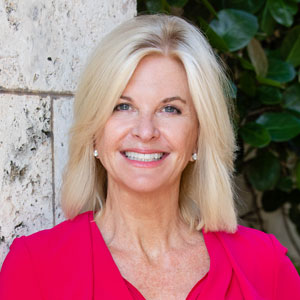
A Fordham trustee and the executive trustee of the Stephen E. Bepler Estate and Trust, Kim Bepler is one of the University’s most generous supporters. Since her retirement in 2002, she has devoted much of her time to philanthropy, focusing her efforts on causes directly related to the Jesuits and Jesuit education. She received an honorary doctorate of humane letters from Fordham in May, and in 2007, she was a recipient of a Fordham Founder’s Award, alongside her late husband, Steve Bepler, FCRH ’64.
She recently supported the creation of an endowed chair in the natural and applied sciences, adding to the four endowed chairs—in mathematics, physics, chemistry, and biology—she and the estate of her husband established five years ago. She also has helped create and support student scholarships, including the Fordham Founder’s Undergraduate Scholarship Fund, and contributed to renovations to the University Church and the McShane Campus Center, among many other initiatives.
Mary Byrne, Ph.D., TMC ’72, GSAS ’78, ’83, PAR
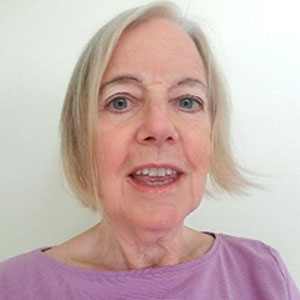
A three-time Fordham graduate, Mary Byrne is a clinical psychologist with a private practice in Eastchester, New York, that focuses on individual psychotherapy for adults with anxiety and depression. Previously, she was a staff psychologist at Four Winds Hospital in Katonah, New York, and worked on the crisis unit of the Community Mental Health Center in Bridgeport, Connecticut.
In 2009, Byrne and her husband, Thomas Rogan, established an endowed scholarship fund at Fordham to benefit doctoral candidates in psychology. They named the fund in honor of Marvin Reznikoff, Ph.D., her doctoral dissertation mentor who became a family friend. After he died in June 2013 at age 88, Byrne spoke at a memorial service at Fordham. She said Cicero “must have been thinking about someone like Marvin” when he observed: “The life given us by nature is short, but the memory of a life well spent is eternal.”
Joy Fernandez, GABELLI ’88
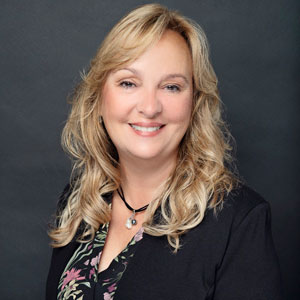
After graduating from Fordham with a degree in accounting, Joy Fernandez began her career at EY in the entrepreneurial services group. After her children were born, she adopted a flexible work arrangement—and it didn’t stand in the way of her making partner in 2003: Fernandez was the Long Island office managing partner for five years before transitioning into her U.S. East regional independence leader role. She has been a generous supporter of the Gabelli School of Business Undergraduate Scholarship Fund and the school’s accounting program. EY is also an annual sponsor of the summit.
Kathleen Anne Ford, J.D., FCRH ’75, LAW ’78
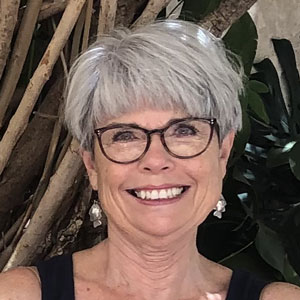
Kathleen Anne Ford was a member of the first class of women to graduate from Fordham College at Rose Hill in 1975. After earning a J.D. from Fordham Law School three years later, she spent her entire career in public service, including roles at the Brooklyn District Attorney’s Office, the Organized Crime Strike Force, the United States Attorney’s Office, the Office of Enforcement Operations at the U.S. Department of Justice, and the Securities and Exchange Commission. She received numerous awards throughout her career, including the Attorney General’s Award for Exceptional Service, the FBI Director’s Letter of Recognition, and the SEC Chairman’s Award for Excellence.
At Fordham, she and her husband, Joseph Ford, established the Kathleen Anne Ford, FCRH ’75, LAW ’78, Endowed Scholarship Fund in 2013. Since then, it has provided financial support for two students at Fordham College at Rose Hill and two at Fordham Law.
Theresa Lim Mao, Ph.D., GSAS ’60, ’64
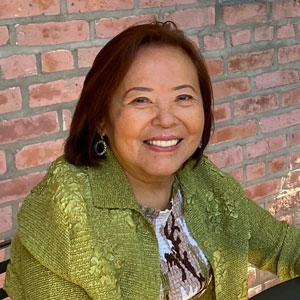
Theresa Lim Mao is a retired chemist, businesswoman, and philanthropist. A native of Taiwan, she moved to the U.S. when she was 18 years old. In 1964, after earning her Ph.D. from Fordham, she was hired by Exxon Mobil Corporation, then known as Esso Research, as the company’s first female chemist with a doctorate. Unfortunately, when Mao was 46, her husband, Peter T.H. Mao, M.D., died suddenly, leaving her to provide for their two daughters and prompting a career switch to real estate investment. At Fordham, Mao recently started a fund to support Campus Ministry retreats and other events to foster a greater sense of community among graduate students.
Ann Marino, R.S.H.M., MC ’63
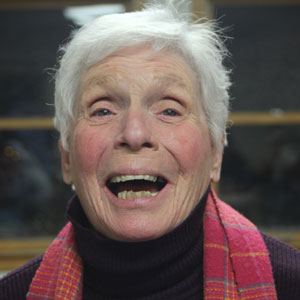
A Catholic nun, Ann Marino grew up in the Bronx and graduated from Marymount College in Tarrytown in 1963. Sister Marino entered the Religious of the Sacred Heart of Mary in 1957, and since then, she’s taught in schools owned and staffed by the R.S.H.M. in New York and in Colombia, Spain, and Italy.
Anne Williams-Isom, FCLC ’86
Anne Williams-Isom is the James R. Dumpson Chair in Child Welfare Studies at the Graduate School of Social Service and a 2018 recipient of an honorary degree from the University. In January 2022, New York City Mayor Eric Adams appointed her to serve as deputy mayor for health and human services. A native of Queens and an alumna of Fordham College at Lincoln Center, she earned a J.D. from Columbia Law School. Prior to serving as a deputy mayor, Williams-Isom was chief operating officer and then chief executive officer of the Harlem Children’s Zone. She began her career in child welfare as the deputy commissioner of community and government affairs at the New York City Administration for Children’s Services.
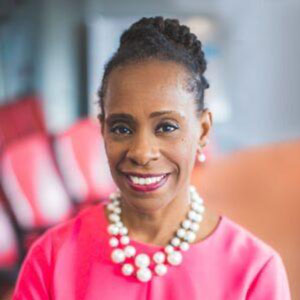
She has been a loyal supporter of the Fordham Founder’s Undergraduate Scholarship Fund, Fordham’s Higher Education Opportunity Program, and a member of the President’s Council, a group of successful professionals and philanthropists committed to mentoring Fordham’s future leaders.
A total of 33 women have been honored as Pioneering Women in Philanthropy since 2017, helping to provide Fordham and its students with resources, mentorship, and support.
If you missed the 2022 Women’s Summit, check out our full coverage of the day.
]]>The new chair is in addition to four others in the sciences that she and the estate of her late husband, Steve Bepler, FCRH ’64, funded in 2017. To be titled the Kim B. and Stephen E. Bepler Chair in the Natural and Applied Sciences, the new position is expected to advance the University’s vision for excellence in science education by fueling new interdisciplinary research into today’s most pressing scientific challenges.
“I want to thank Kim Bepler on behalf of the generations of Fordham students who will benefit from her extraordinary generosity,” said Tania Tetlow, president of Fordham. “Kim understands the University’s needs as well as anyone, and has long been committed to high-impact philanthropy that furthers academic excellence and our Jesuit, Catholic mission. We are deeply grateful for her gift, and for her ongoing engagement with Fordham.”
The gift comes as Fordham is seeking to expand its STEM programs in response to students’ growing interest in the sciences. It will advance the University’s $350 million fundraising campaign, Cura Personalis | For Every Fordham Student, and its goal of supporting student-faculty research, cross-disciplinary problem solving, and other facets of academic excellence.
The new Bepler chair will enable the University to recruit an intellectual leader and well-established scholar and teacher and provide this person with robust research support, said Dennis Jacobs, Ph.D., provost of the University and senior vice president for academic affairs. The right chair holder could help attract other talent to the University while providing leadership on important scientific questions that bring multiple fields together, he said.
“Many of the most promising scientific discoveries of our day emerge in the interstitial spaces between disciplines—between biology and physics or between chemistry and math or computer science. Addressing the most complex and consequential problems facing society really requires an interdisciplinary approach,” he said, giving the examples of mitigating climate change, combatting infectious diseases, and reducing the devastating impact of neurological disorders.
For instance, he said, “when we initially fill the endowed chair, our greatest priority may be to recruit somebody who works on next-generation renewable sources of energy. Well into the future, Fordham may choose to recruit a Bepler chair who applies artificial intelligence to identify novel therapeutics or addresses other important issues and problems.”
Philanthropic Impact
The Beplers were already among the University’s most generous donors at the time of Steve Bepler’s untimely passing in 2016. They funded endowed chairs in theology and poetics and gave in support of the Fordham Founder’s Undergraduate Scholarship, the restoration of the University Church, a new organ for the church, deans’ discretionary funds, and many other areas.
Kim Bepler also recently made a major gift in support of the Joseph M. McShane, S.J. Campus Center project, another critical piece of the Cura Personalis campaign, and created the Fordham Ukraine Crisis Student Support Fund to help the University’s Ukrainian and Russian students facing financial peril because of the Russian invasion.
“With this bold and generous investment, Kim helps set the pace for leadership support,” said Roger A. Milici, Jr., vice president for development and University relations at Fordham. “Our Trustees have strongly supported all of Fordham’s recent fundraising campaigns: their gifts have accounted for 35% or more of each effort. Fordham’s philanthropic culture is dynamic, and we are committed to helping our mission partners use their wealth and generosity to improve the human condition.”

The four other Bepler chairs in the sciences—established as part of a $10.5 million gift—include a chair in biology, held by Silvia Finnemann, Ph.D., who studies the neurobiology of the human retina, and one in chemistry, held by Joshua Schrier, Ph.D., who is pursuing possibilities for automated scientific research.
The University is seeking to fill the other two chairs—one previously held by the mathematician Hans-Joachim Hein, Ph.D., and one that will be directed towards biophysics, Jacobs said.
The gifts to establish these four chairs, as well as the new chair, reflect Steve Bepler’s desire to give back to the University by investing in world-class science programs that he felt any world-class university needs, Kim Bepler said.
“Steve deeply loved Fordham, and it’s a privilege to be able to help realize his vision for the University and cement his legacy like this,” she said. “I’m honored to be counted among those who are supporting our extraordinary science faculty, with their dedication that so clearly shows the Jesuit principle of magis at work, and I’m excited to see how this professorship will help our science programs grow in new directions.”
Building Connections
Schrier said he decided to come to Fordham as a Bepler chair because of the University’s Jesuit identity and because the position offered greater freedom to not only pursue research but also involve undergraduate students in it.
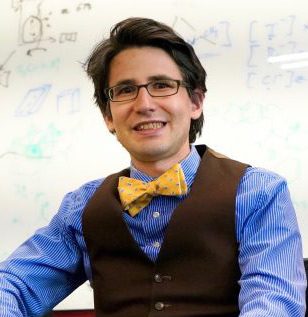
The endowed chair creates a few different benefits, he said—it expands the faculty and creates capacity for new types of classes that might not be offered otherwise. And by allowing for exploratory, proof-of-concept projects, “it really kind of serves as seed money for doing creative and exciting things and then taking those initial results and showing them to federal funders,” he said.
“There’s just tremendous value for interdisciplinary work” in the applied sciences, said Schrier, whose own research applies computer simulations and machine learning to the search for applications for perovskites, a crystalline mineral.
“I hope that the holder of this position will be able to build connections and ties with different departments here at Fordham and show students how all of this type of work is connected,” he said. “I know I have a lot of fun talking to colleagues in math, talking to and working with colleagues in computer science and physics. I think interdisciplinary [work]is great.”
He spoke of a number of such projects, including his work with chemistry and computer science professors to develop teaching labs that expose chemistry students to data science, a model they published last year in the Journal of Chemical Education.
“I’m really excited about [the new Bepler chair], and I look forward to meeting the holder of the chair,” Schrier said, “because it’s always great to add to and build our intellectual community here at Fordham.”
The Kim and Steve Bepler chairs have contributed to an increase of more than threefold in the number of endowed chairs at Fordham over the past two decades. The new chair in the natural and applied sciences will bring that number to 73.
]]>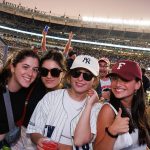



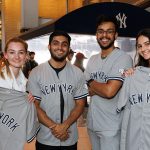

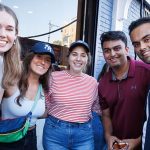
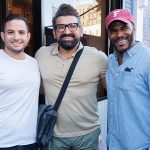
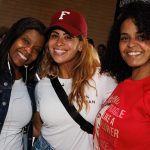

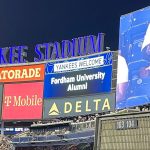
 The Fordham alumni who attended the September 8 Yankees game in the Bronx didn’t get to see a win for the home team, but at least they had a lot of fellow Rams around to commiserate with as the first-place Yanks’ once-impressive division lead continued to shrink.
The Fordham alumni who attended the September 8 Yankees game in the Bronx didn’t get to see a win for the home team, but at least they had a lot of fellow Rams around to commiserate with as the first-place Yanks’ once-impressive division lead continued to shrink.
More than 1,300 people joined the Fordham University Alumni Association at Yankee Stadium to watch the Twins squeak out a 4-3 victory over the Bronx Bombers on a night that began with a pregame reception for alumni at Yankee Tavern on 161st Street, continued with the distribution of special-edition, Fordham-branded Yankees jerseys inside the gate, and featured no shortage of Rams apparel and block Fs mixed in with the pinstripes and famous interlocking “NY” logo of the Yankees.
Some in the Fordham contingent were seated in right field, just below the Yankee Stadium “Judge’s Chambers” section and a baseball’s toss away from the super-slugging Aaron Judge himself. Among them was the University’s new president, Tania Tetlow, who attended with her husband and daughter and paid a pre-game visit to the press level, where she met with broadcasters Michael Kay FCRH ’82, and Justin Shackil, FCRH ’09, as well as Greg Colello, FCRH ’07, senior director of scoreboard and video production at Yankee Stadium.
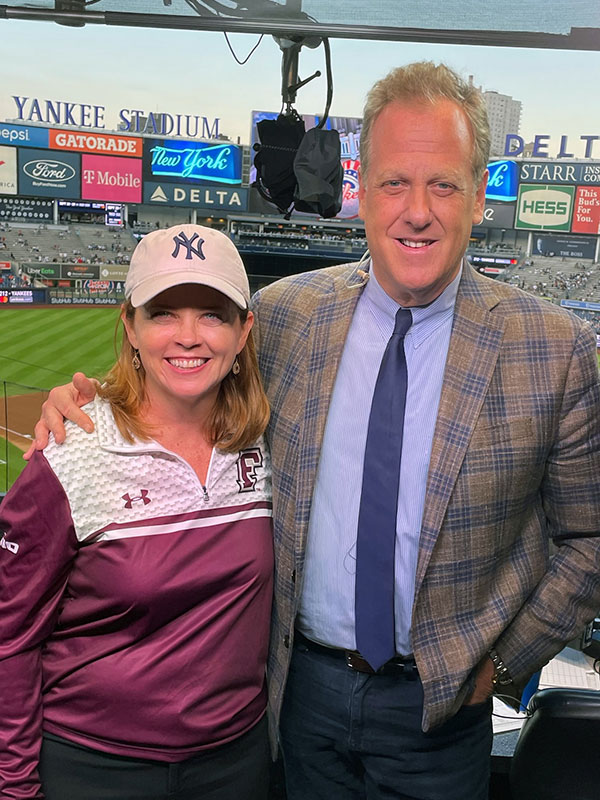
“It’s clear that Fordham loyalty runs deep,” said Tetlow on the strong turnout from Fordham grads. “It’s so exciting to know how much Fordham alumni want to come together and to be at the other heart of the Bronx, Yankee Stadium.”
‘So Much Fordham Spirit Up in the Bronx’
It wasn’t Tetlow’s first game in the Bronx: She said her family had taken one in earlier in the summer, when they first arrived in New York. “We got our requisite gear and hats and started training our daughter, Lucy, on the joy of baseball,” she said. The family’s allegiances had been up for grabs because their former home, New Orleans, doesn’t have a big-league team. But Tetlow said their rooting interests are settled now: “We are fully committed to the Yankees.”
Fordham trustee Kim Bepler said she was excited that large groups could once again gather for “fantastic” events like this. “People want to be with people, and what’s better than going to Yankee Stadium?” she said. “And part of the joy of this is also accompanying our new president. So I get to see her cheer on the Yankees with her family.”
Samara Finn Holland, FCLC ’03, a member of the Fordham University Alumni Association Advisory Board, also praised the outing’s large turnout.
“I think it’s amazing,” she said. “It’s so great to see so much maroon and so much Fordham spirit up in the Bronx. And I think it’s really important as Fordham continues to unify all of its schools to have an event like this, where you have alumni from all the undergraduate colleges, as well as the graduate schools, all be able to come together and then celebrate.”
A Ram on the Mound, Camaraderie in the Stands
The Fordham grads in attendance got to see one of their own on the field: Greg Weissert, GABELLI ’18, who made his big-league debut on August 25, becoming the first Fordham grad to play for the Yankees since Johnny Murphy in 1946.
Weissert’s appearance in the Fordham Night game marked the seventh outing of his rookie season, in which he’s shown off deceptive sinkers and sliders, as well as a wicked two-seam fastball. A day after picking up a win with an efficient three-pitch outing to improve his record in relief to 3-0, Weissert entered in the eighth, giving up a home run that would prove to be the difference in the game.
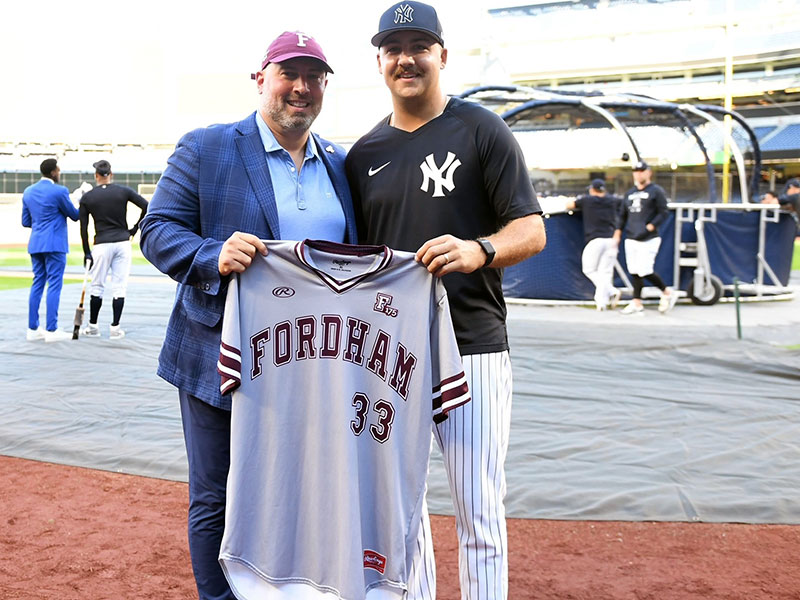
But while the outcome of the game wasn’t what the Yankees fans in the Fordham group were hoping for, the night was about more than the result on the scoreboard.
Steve O’Dowd FCRH ’78, said he and his wife had been planning to come up to the New York area from the Jersey Shore for a wedding the weekend after the game. But when they heard about the alumni outing, they extended their trip (and added a pre-game detour to Arthur Avenue).
“I actually became a Yankees fan starting around the time I went to Fordham,” said O’Dowd. “Prior to that, I was a Mets fan, believe it or not. We’d cut classes and come to a lot of games. Thurman Munson was my hero; that’s why I have this number [15] on my jersey.”
Debbie Myllek, FCRH ’90, another former Mets fan who switched sides upon arriving at Fordham, said her family jumped at the opportunity to bring two generations of alumni to the event.
“We’re Yankee fans and massive Fordham fans,” she said. “My husband and I met at Fordham; I was a sportswriter on The Ram and he was my editor. Now both of our kids go to Fordham. For our friend group, we try to make sure we all sit in the same section, and now my son and his friend started doing the same. It’s really nice.”
—Joe DeLessio, FCLC ’06
]]>All of you have traveled to Rome before. How was this experience different?
AN: This was my first pilgrimage. Our access to the Vatican hierarchy, our meeting with the head of the Jesuits, the opportunity to bond with other members of Fordham—and the timing of all that with our new leadership—was quite extraordinary.
KB: Eight years ago, I embarked on a pilgrimage with my late husband, Stephen Bepler, the love of my life. Steve loved his Jesuit education at Fordham, and he was fully indoctrinated in how a Jesuit education is a transforming experience. For many years, there was a paperback book on his desk—Ignatius Loyola: Spiritual Exercises by a Jesuit named Joseph Tetlow—and I often saw it, not realizing that someday I would meet his niece, Tania Tetlow. A few months ago, Tania sent me my own copy. I read the entire book before our 2022 pilgrimage and took it with me to Rome. I wanted to see what encouraged Steve about his Jesuit education. I’m glad that I rejoined that extraordinary pilgrimage and spiritual reflection with Father Cecero and, of course, Roger Milici. On the trip, I also met a woman who is agnostic, yet appreciates, admires, and respects what we’re doing. She sees this as an opportunity to understand not only her perspective of what religion is, but to see how people gravitate towards this idea of spirituality and St. Ignatius.
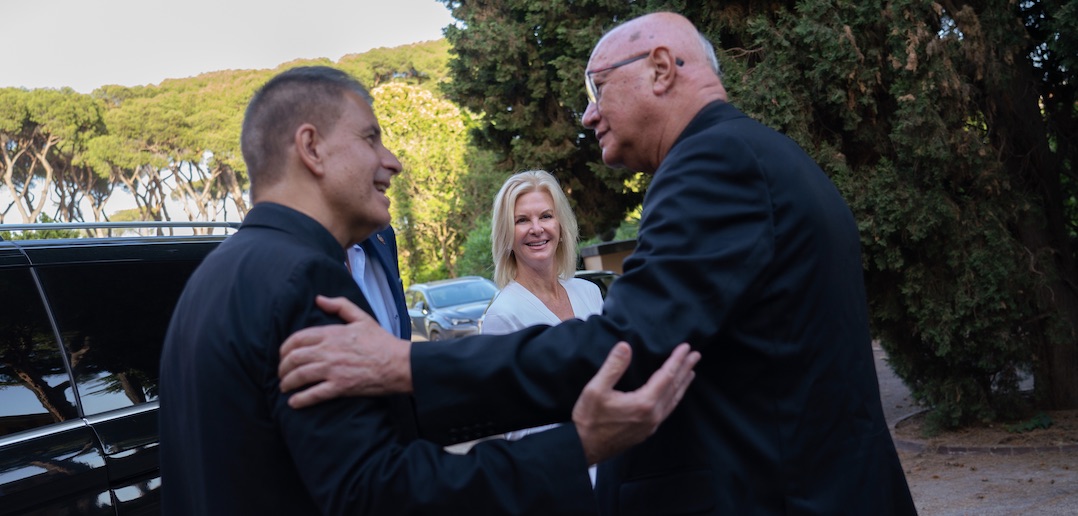
MJB: I first visited Rome 20 years ago on a vacation with my best friend—my first time traveling outside the country as an adult. During this pilgrimage to Rome, my goal was to have a stronger connection with Fordham and a deeper understanding of the history that the University is built upon. When I became a trustee, I learned a lot of information about the Jesuits. But it’s different to experience something in person, instead of reading about it. This trip was more of a lived experience and it gave me the opportunity to spend time with Tania, fellow trustees, and other friends of Fordham. Overall, the pilgrimage helped me to deepen my love for and commitment to the University and allowed me to look within myself.
What is your relationship with the Catholic faith?
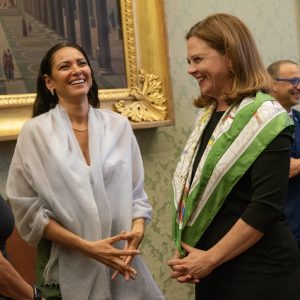
AN: I am Catholic. I’m the beneficiary of a Jesuit education, between Xavier High School and Fordham, and I continue to experience a deep appreciation for the history, legacy, and continued leadership of the Jesuits.
KB: I was born and raised Catholic. While I don’t necessarily look to the hierarchy of the church, I follow my heart and my spirituality in the journey of my life to understand something that is bigger than I am.
MJB: I was raised Catholic. I respect many things that I learned from my Catholic upbringing and other faiths, but it took me a long time to understand what I believe in and what’s important to me. I don’t like putting myself in a box, but I would identify as spiritual.
What was one of your favorite sites you visited during the pilgrimage?
AN: I’ve visited the Sistine Chapel many times, but every time I walk inside, it feels like the first time. It’s such a powerful experience to see the hand of God through Michelangelo.
KB: The quarters of St. Ignatius himself. Sitting there and experiencing Father Cecero’s Mass—and then hearing Tania Tetlow, a trained opera singer, sing a hymn—was utter perfection. It was simple, but so powerful that it took my breath away.
MJB: There were so many sites. When you’re in a place like a church, it evokes the enormity of so much history. It reminds you of how small we are and how big the world is, of everything that’s come before and everything that’s to come after. I loved being in a place where that history felt palpable.
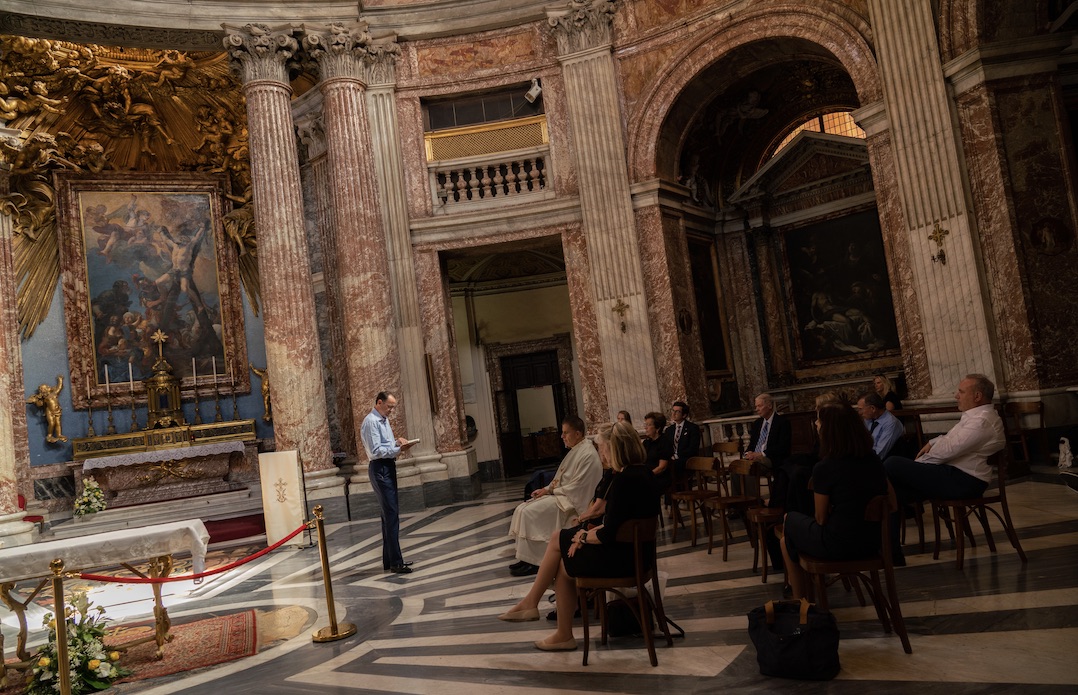
How do you feel the delegation’s meetings at the Vatican have helped to advance Fordham’s mission?
AN: It was gratifying and reassuring to hear Cardinal Versaldi talk about how our mandate in Catholic education is global because Fordham itself is global. Nearly 9% of the undergraduate class of 2026 comes from outside the U.S., and we have a London campus and plenty of study abroad opportunities for our U.S. students. We still have room to expand. It’s important that we continue to form relationships with other Jesuit and Catholic institutions around the world. It’s part of the mandate of being Jesuit, of being global. Our new ties with the Vatican will continue to be important as we enter this next exciting chapter at Fordham with President Tetlow.

KB: It was extraordinary to be brought into the Vatican and to meet the hierarchy of not only our church, but also the Jesuits. This is critical because we are developing new diplomatic ties for Fordham in Rome. I hope that on our next trip there—hopefully a year from now, where more trustees will join us and understand the value of this pilgrimage—that we have a two-way dialogue with Villa Nazareth.
MJB: I enjoyed our meeting with Cardinal Versaldi, who spoke about respecting the roots and the history of the Catholic church while being able to change with the times. I was pleasantly surprised to hear him bring that into the conversation.
Why was this trip so important at this particular time in Fordham’s history?
AN: We are a Jesuit university, but our students come from many different backgrounds. Irrespective of their religious affiliation—or no affiliation at all—the concept of a Jesuit education still resonates with them. As we transition to lay leadership, we as a board have more responsibility than ever to uphold our identity as the Jesuit University of New York.

This interview has been edited and condensed for clarity. This article is part of a series of stories about the Rome pilgrimage. Read the original full-length story here.
]]>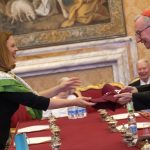
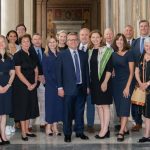
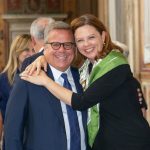
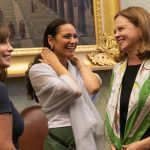

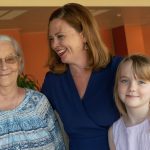
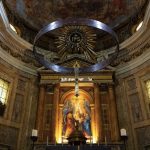
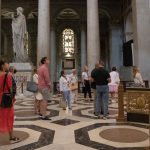
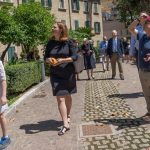
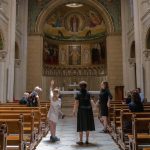
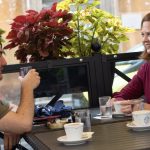
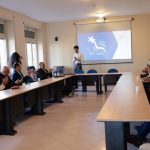 One week before taking the helm as the 33rd president of Fordham, Tania Tetlow accompanied a University delegation to Rome—a city with deep ties to the Jesuits—to mark the 500th anniversary of the spiritual conversion of St. Ignatius Loyola. In a weeklong trip in late June, the group walked in the footsteps of St. Ignatius—the founder of the Society of Jesus—who spent 15 years in Rome. They also met several Vatican officials and the superior general of the Jesuits.
One week before taking the helm as the 33rd president of Fordham, Tania Tetlow accompanied a University delegation to Rome—a city with deep ties to the Jesuits—to mark the 500th anniversary of the spiritual conversion of St. Ignatius Loyola. In a weeklong trip in late June, the group walked in the footsteps of St. Ignatius—the founder of the Society of Jesus—who spent 15 years in Rome. They also met several Vatican officials and the superior general of the Jesuits.
“It was an extraordinary chance to come to Rome, to the center of the church,” said Tetlow, who went on the pilgrimage with family, trustees, and alumni. “It was a chance for the board and other friends of Fordham to commit to the mission and to understand the broader global church, and it was pretty special inspiration for me as I begin the work ahead.”
A Pilgrimage to the ‘Heart of the Church’
The pilgrimage was inspired by the life of Iñigo de Loyola, a young soldier from a noble Basque family in the 1500s who once sought fortune and fame. When his leg was shattered by a cannonball in battle, he spent months recovering at his family home. It was during this crucial time that he began learning about Jesus and the lives of the saints. These stories and this period of discernment in recovery inspired his spiritual conversion. He decided to dedicate the rest of his life to the service of God and humankind.
Iñigo de Loyola, now known as St. Ignatius, went on to co-found the Society of Jesus in 1540. He and his religious brothers made their first home in Rome, where they lived in a small house between what is now the Piazza di Spagna, the “Spanish Steps,” and the Piazza del Popolo. Today, the Society of Jesus is the largest male religious order in the Catholic Church.
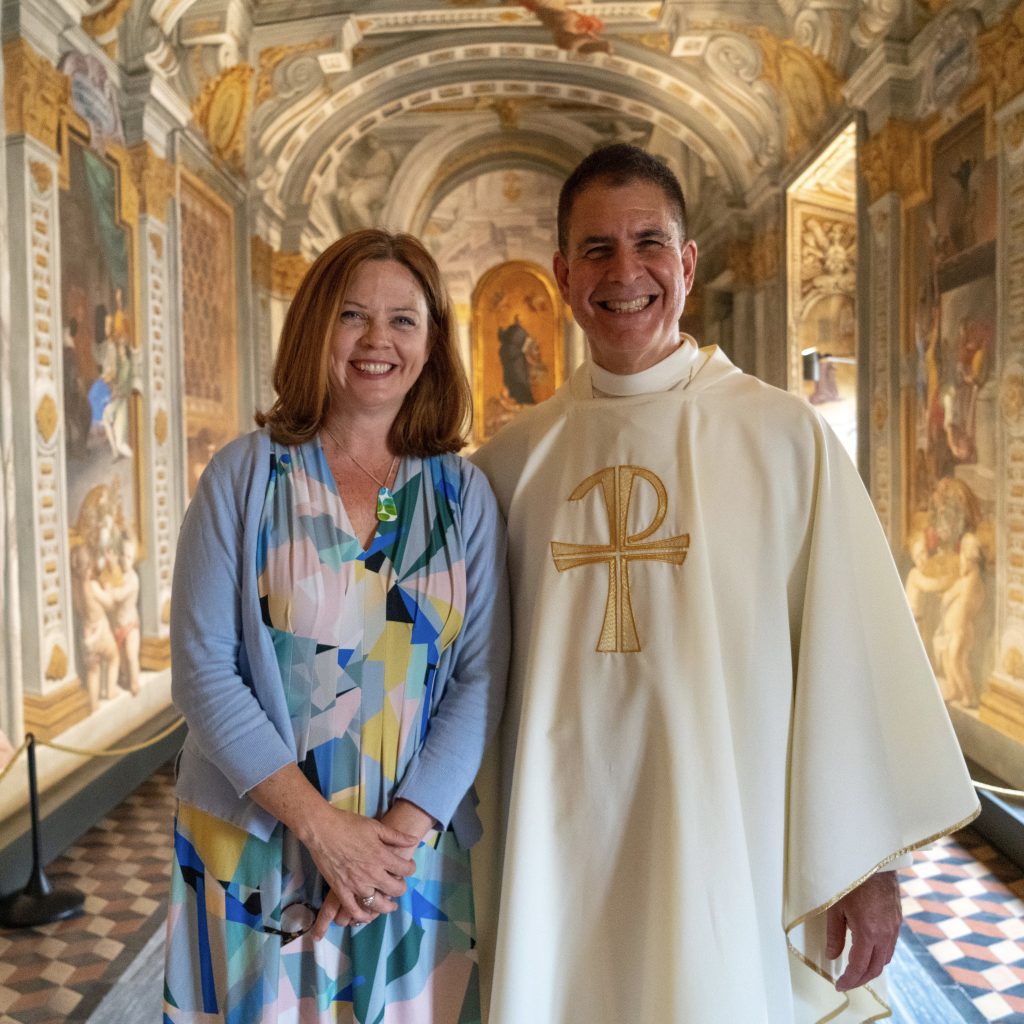
In honor of the 500th anniversary of St. Ignatius’ conversion, Jesuit communities across the world have been participating in a yearlong celebration, the Ignatian Year, beginning on May 20, 2021. Fordham has hosted celebratory events since last spring and will continue the celebration of St. Ignatius and his legacy until July 31, 2022, the Feast Day of St. Ignatius Loyola.
The Fordham trip to Rome served as the highlight of the yearlong celebration, featuring the University’s new leader, Tetlow: the first layperson and woman to lead the Jesuit University of New York.
“The timing of this trip couldn’t have been better as we transition now to our first lay president. It reinforces our responsibility as trustees to ensure the awareness of our Jesuit ideals, mission, and identity, and it’s our firm belief that through all of this, we can be—even with a lay president—more of a Jesuit university than we were previously,” said Armando Nuñez, GABELLI ’82, chair-elect of Fordham’s Board of Trustees.
The pilgrimage was also a “special” experience for the nearly two dozen members of the Fordham community who traveled to Rome, said John Cecero, S.J., vice president for mission integration and ministry.
“Coming here to the heart of the church, to have these conversations and to generate that awareness, was so special,” said Father Cecero. “To come here and walk in the steps of Ignatius, visit the sites that were so important to him, and meet the leaders of the church has been so precious.”
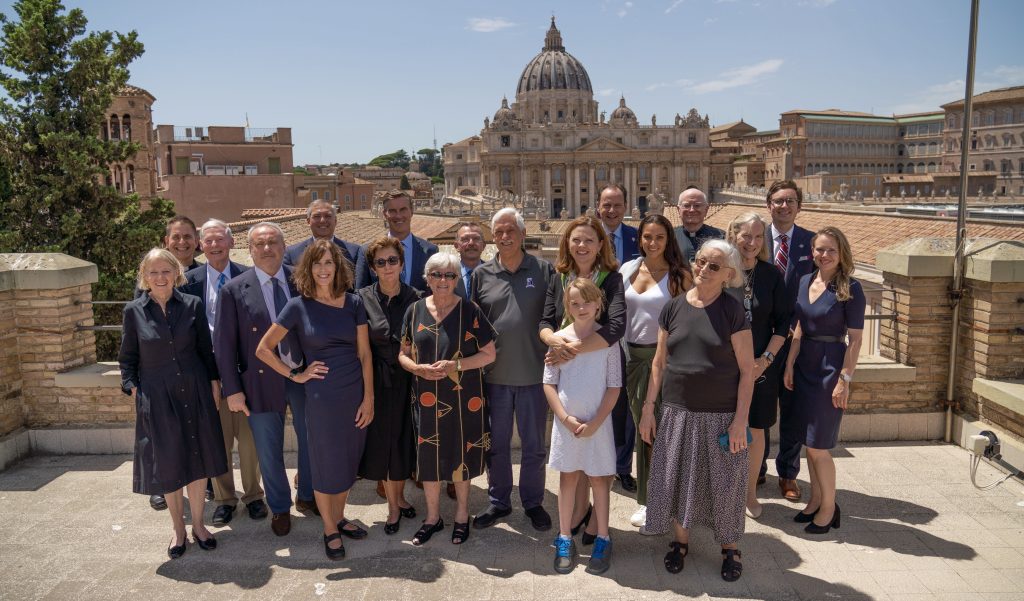
Exploring the Life and Home of St. Ignatius
On the first day of the trip, those who were fortunate enough to escape the effects of jet lag explored the beginnings of Christianity in Rome. They first visited the Roman Forum, the ruins of ancient government buildings, where they learned about the Roman context of early Christianity with an archaeologist. Then they visited the Basilica of San Clemente, a set of three tiered churches from the 1st, 4th, and 12th centuries, featuring detailed Christian mosaics.
The next day, the Fordham delegation immersed themselves in the life of St. Ignatius. In a series of guided tours, they explored the Santa Maria Maggiore, where St. Ignatius said his first Mass; the Gesù, the first Jesuit church in Rome that became the final resting place for St. Ignatius; and the Church of St. Ignatius.
“The Church of St. Ignatius is a beautiful and central place for us, not only because it contains the remains of the saints Aloysius Gonzaga, John Berchmans, and Robert Bellarmine, but also the architecture, art, and ceiling of the Jesuit artist Andrea Pozzo,” said Father Cecero. “All of this speaks to the Jesuit emphasis on integrating art, science, and beauty as an expression of God’s creation and as a way to reflect back to God our gratitude for his creation and the beauty that surrounds us.”
In a private tour, Tetlow and the Fordham delegation also explored the building where St. Ignatius directed the Society of Jesus as their first Superior General. It was here that he wrote the Constitution of the Society of Jesus, as well as handwritten letters to Jesuits who lived across the world.
In a small room, Father Cecero held a group liturgy and Tetlow, a professionally trained opera singer, sang the “Salve Regina.” Later that afternoon, they visited the Basilica of St. Paul Outside the Walls, the church where St. Ignatius and his early companions made final vows after the founding of the Jesuit order.
“St. Ignatius is my saint,” said Ignacio Fernández de Lahongrais, GABELLI ’87, whose great-uncle, father, and son all share the same first name. “It was very emotional to have Mass where St. Ignatius gave Mass. It was also absolutely wonderful to be where he lived and to learn more about his life and what he stood for.”
An Inspiring Message From the Vatican Prefect for Catholic Education
On the third day of the trip, the Fordham delegation traveled to the Vatican City, where they met Cardinal Giuseppe Versaldi, Vatican prefect for Catholic education, and Monsignor Guy-Réal Thivierge, secretary general of the Pontifical Foundation Gravissimum Educationis.
In an address to the Fordham delegation, Cardinal Versaldi discussed the importance of teaching about an inclusive faith through Catholic education. He emphasized that schools should maintain their core Catholic values, but continue to respect and welcome people from all walks of life. In addition, he applauded Fordham for its quality of education in a modern world.
“I’m sure you will continue this communion with the church, keeping your autonomy and your independence, but also the capacity to work together and to offer a contribution to a new world,” Cardinal Versaldi, who prompted the Society of Jesus to create the Mission Priority Examen, said to the Fordham delegation.
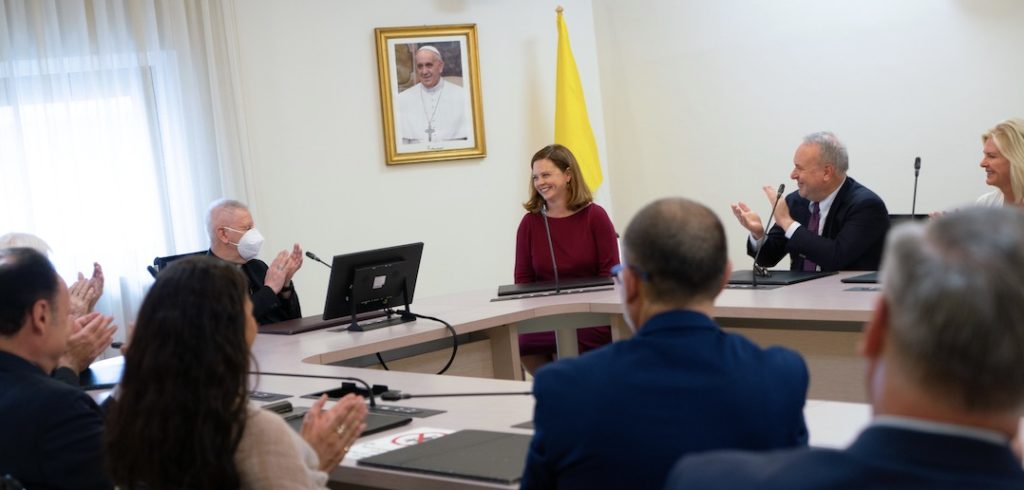
The cardinal’s message was inspiring, particularly for those who grew up in a period that was less inclusive, said Elizabeth “Betty” A. Burns, FCLC ’83, a former trustee who was raised Catholic. The cardinal’s speech was also surprising in a positive way, said Robert Smolens, husband to Donna Smolens, FCRH ’79, GSAS ’81.
“I thought he would be a little more dogmatic and concerned about, as he put it, this secularization that’s going on in the world. It’s not the same place that it was 30, 40 years ago, when my wife and I were in school,” said Smolens, who was raised in a Jewish household and is married to a Catholic. “But he welcomes the challenge of 2022, and that’s what we need to still have a great Catholic university.”
The overall message from the cardinal and his associates is important to Fordham and its mission, said Kim Bepler, a University trustee and philanthropist who earned an honorary doctorate from Fordham this May.
“It was so inspiring and forward-thinking to hear what the monsignor and the cardinal had to say about the Catholic identity, the mission of the Jesuits, and that we don’t lose sight of the mission of Fordham,” said Bepler. “We are inclusive, and we are also welcoming. As the educational model changes, we change—and it’s for the better.”
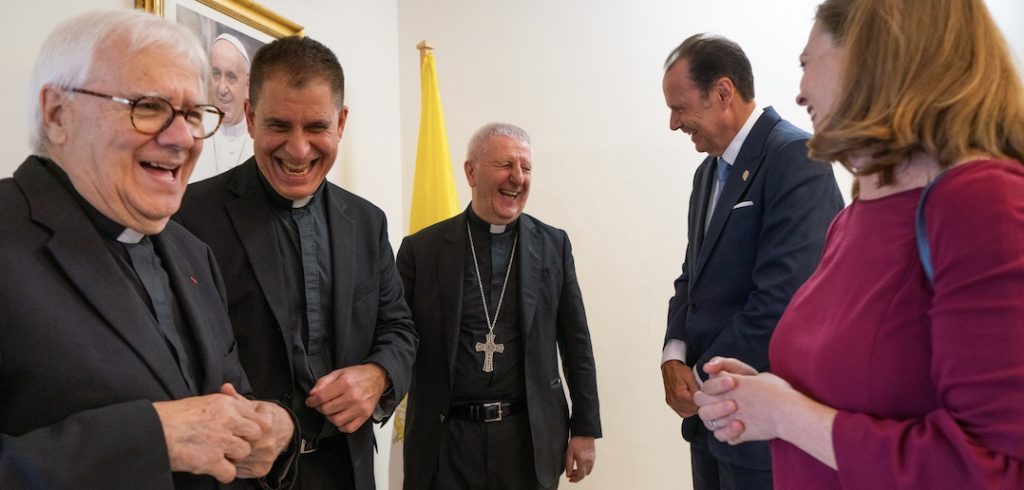
Meeting the Vatican Secretary of State
On their final day of the trip, the delegation met Cardinal Pietro Parolin, Vatican secretary of state, in the heart of Vatican City. The Fordham delegation awaited the cardinal in the Apostolic Palace, the official residence of the pope, where they sat in ornate chairs and were surrounded by elaborate paintings. For a few minutes, the room was silent except for hushed whispers and the continuous ticking of a grandfather clock. When the cardinal arrived from an entrance in the corner of the room, everyone immediately rose from their seats.
In a 20-minute speech, the cardinal echoed the words of his associates and wished the Fordham delegation well on their trip.
“It is my hope that on your pilgrimage to Rome, your experience of Christian sites and your visits to places associated with the life of St. Ignatius will prove inspiring and sustain you in joyful and hope-filled love for Christ and one another,” Cardinal Parolin said to the Fordham delegation.
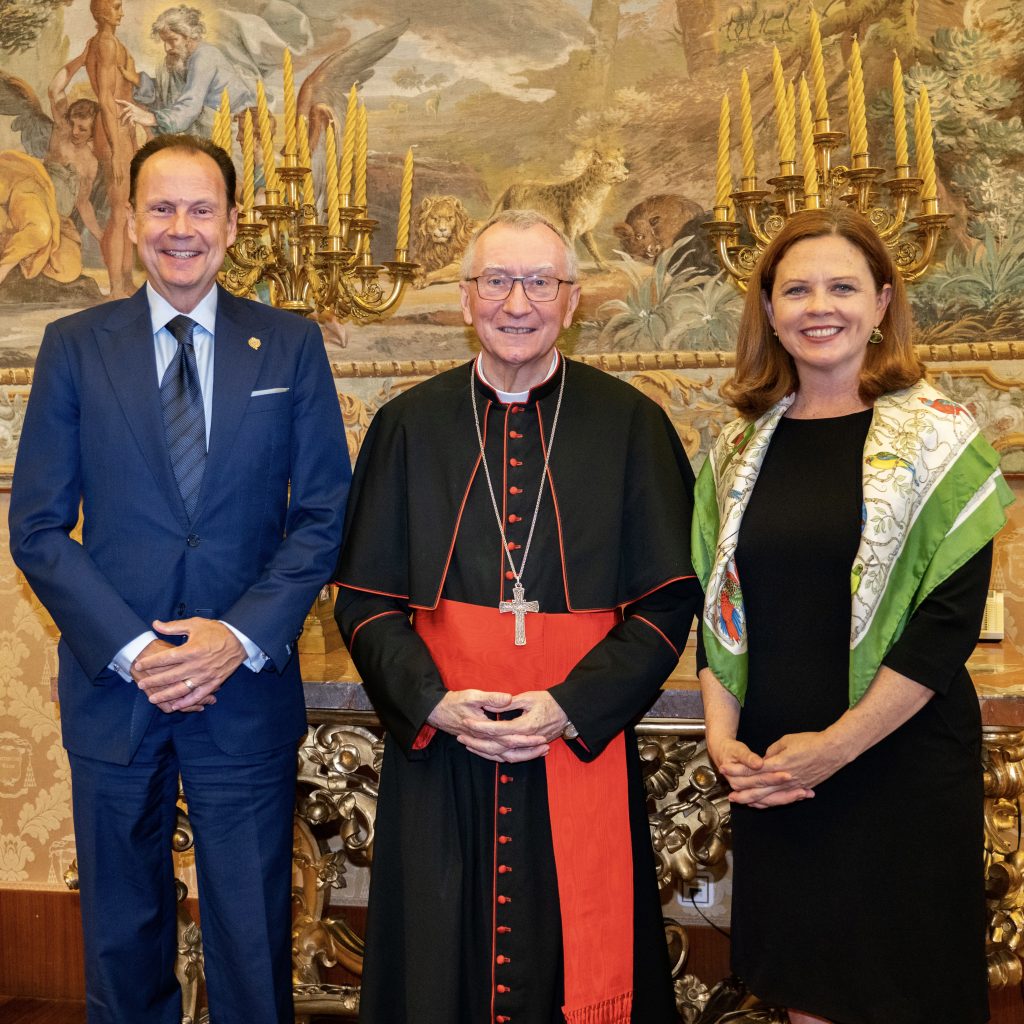
Tetlow thanked him for his words and offered her own thoughts on the future of Catholic education. Historically, Catholic schools and universities have offered opportunities to students from all different backgrounds, including immigrants and first-generation students, she said. Their core mission has been supported by not only priests, but the lay people, she added.
Now, in a time when the U.S. and the American Catholic Church are increasingly divided, Fordham’s Catholic identity offers a reminder of our common values and the need to serve the common good, she said. She also acknowledged that Fordham serves students from many faiths, increasingly those who have no religious background. It is important that the University does not “preach to the choir,” but encourage respect for the church, the Catholic faith, and people from all walks of life, she said.
“We ask students to put aside their own ideas and be willing to think of new ideas and to embrace faith and spirituality, and we teach that openness by modeling it ourselves,” she said to Cardinal Parolin. “It is not an easy task right now, but we work very hard to make that manifest at Fordham, which is one of, as you described, the finest Catholic universities in the world. And so it is a great responsibility for me—for this board, for this community—to do that well, and it is the privilege of our lives to serve the church in this way.”
At the end of their exchange, Tetlow gifted Cardinal Parolin with a Fordham baseball cap. The cardinal immediately placed it over his red skullcap and waved at the staff photographer, while the Fordham delegation laughed appreciatively. As the delegation filed out of the room, he handed each member a blessed rosary.
“I love the fact that we’ve got more Fordham baseball caps wandering around Rome,” Kim Bepler later said during a car ride in Rome.
“We did leave one for the pope, so maybe we’ll see him appear on the balcony someday with a Fordham cap on,” said Father Cecero, chuckling. (Pope Francis was unfortunately unable to meet with the Fordham delegation.)
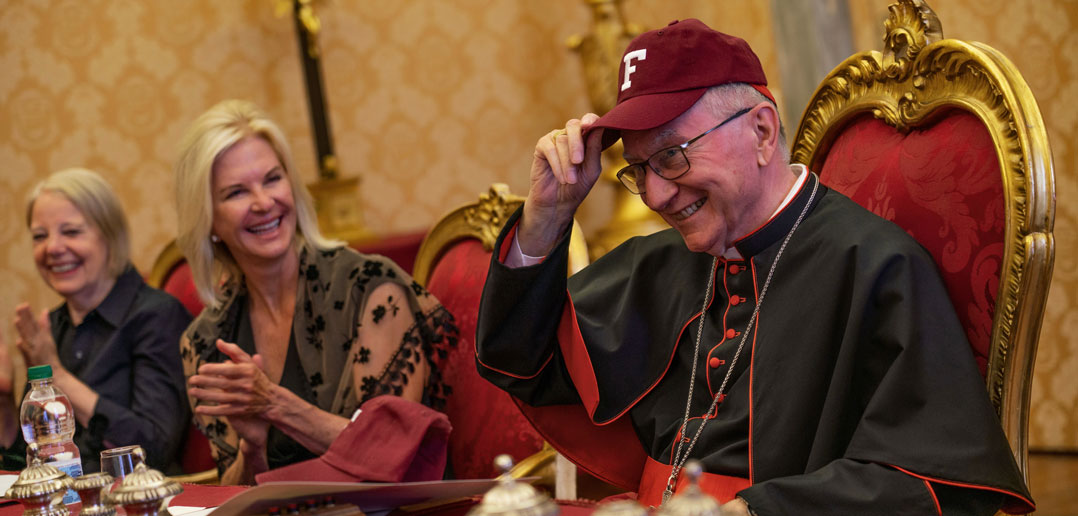
A Visit to the Jesuit Headquarters to Meet the Superior General
Later that afternoon, the Fordham delegation met Arturo Sosa, S.J., superior general of the Society of Jesus, on the rooftop of the Jesuit Curia in Rome—the headquarters of the Jesuits.
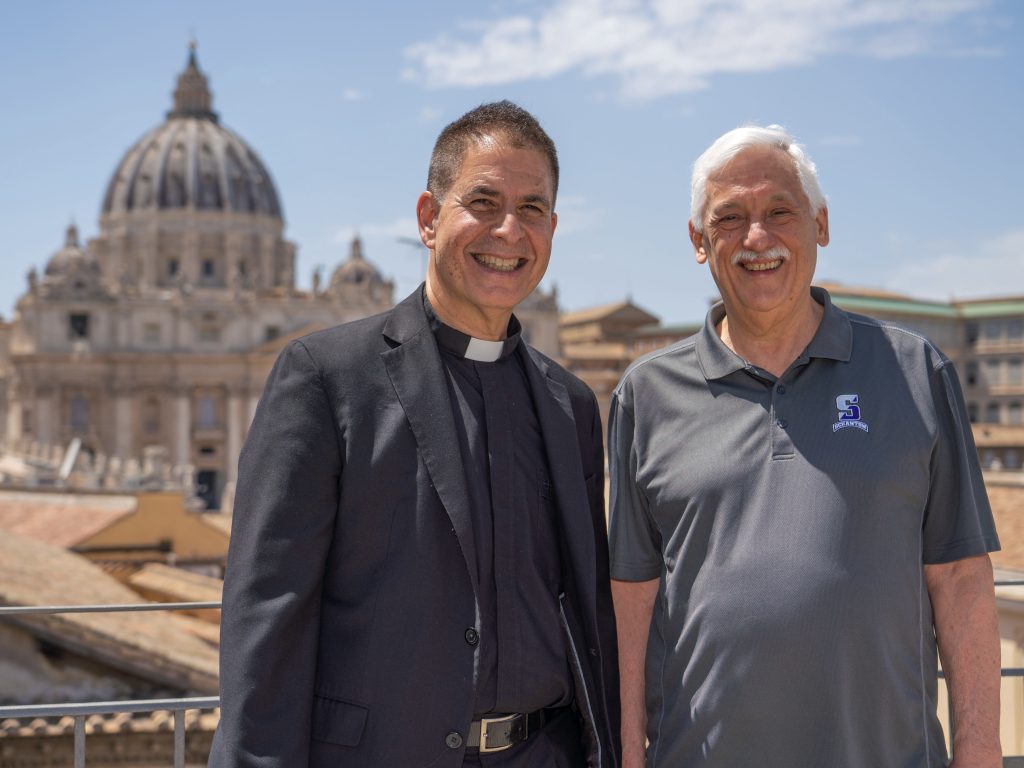
“It was a real treat to meet the Father General. He was wise and wonderful and a lot of fun,” said Tetlow, who shared a private meal with him. “[We talked about] matters big and small: the transition to lay leadership, the state of Jesuit universities in the U.S. and around the world, and opportunities for all of us to partner more with each other across national borders.”
Afterward, the Fordham delegation toured the Curia, including the chapel, gardens, and the dining room, where they sampled freshly picked fruit from the Curia’s own backyard.
In the delegation’s final outing as a group, Father Cecero held Mass at Sant’ Andrea al Quirinale, the third Jesuit church constructed in Rome, where young novices once studied. People offered prayers—for the people of Ukraine, for Tetlow and her family as they start their new journey at Fordham, and for Father Cecero, who spearheaded the pilgrimage.
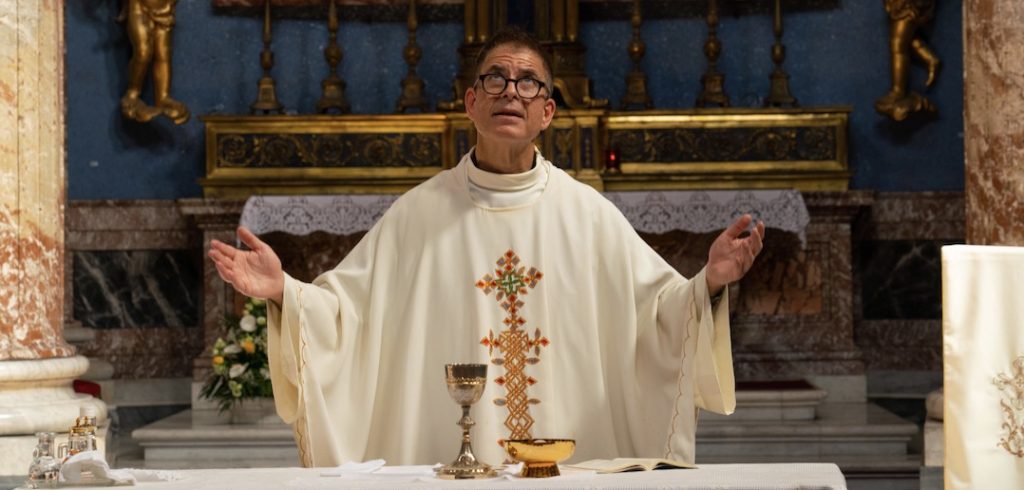
Returning Home with A New Vision for Fordham
Each Vatican official from the pilgrimage affirmed the importance of “service, engagement, and encounter”—three concepts that are critical to the mission of Fordham’s Center for Community Engaged Learning, said the center’s executive director, Julie Gafney, Ph.D., who was part of the Fordham delegation.
“This is so crucial because this is the work that the center does at Fordham. We often talk about our mission internally at Fordham, but to hear these leaders express that this is the bedrock on which our educational tradition is founded—and also an area for innovation in education—was so powerful and something I want to bring back and continue to grow at Fordham,” said Gafney.
Gafney said that many Jesuit schools have become strong research institutions, but it’s important for them to remember the roots of the Jesuit tradition: educating young people, especially those from underprivileged backgrounds.
“Our center offers tutoring, mentorship, college access programming, and mental health services to youth-serving nonprofits and local schools in partnership with faculty and students. I’d really like to scale and increase those forms of engagement, since they can be deeply impactful and align powerfully with our mission,” said Gafney, who also oversees programs like Urban Plunge and Global Outreach. “I’d like to have 1,000 Fordham students serve as tutors and mentors. It’s doable. It’s needed. And I think it could be really powerful—both for the middle and high school students and the Fordham undergraduates.”
Building Relationships Abroad
On the last day of the pilgrimage, several members of the Fordham delegation visited Villa Nazareth, a Vatican-affiliated residential college for talented students from low socioeconomic backgrounds in Italy, where they toured the facilities, interacted with present students, and discussed an invitation from Cardinal Parolin to establish a partnership with Fordham.
The school was established in 1946, one year after World War II ended, to help orphans reach their potential. Since then, Villa Nazareth has become a prestigious institution that educates and houses students, free of charge. The institution, managed by a nonprofit called the Comunitá Domenico Tardini Association, has received attention from many visitors, most notably Pope Francis in 2016, and is led by Cardinal Parolin.
The visit was an opportunity for Fordham to expand its global footprint and establish a new relationship with a school in Rome that shares the same mission.
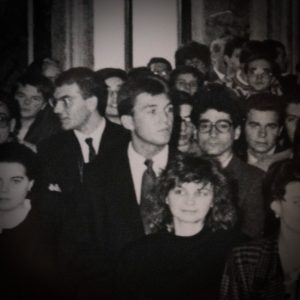
“The mission of our schools is to deliver cura personalis, and what you have described about what happens here is exactly that—to care for the whole student,” Father Cecero said, addressing administrators at Villa Nazareth after listening to a PowerPoint presentation about the school’s mission. “You’ve given us important seeds to ponder about how we can creatively work with you because we share a very common mission.”
The visit was also a homecoming for Roger A. Milici Jr., vice president of development and university relations at Fordham, who studied at Villa Nazareth in 1986 and 1987. On the wall of a campus building, Milici pointed to a black-and-white group photo of students from several decades ago, featuring his 21-year-old self. “It feels like yesterday,” he said.
Archbishop Claudio Celli, deputy president of Villa Nazareth, embraced the potential of a new partnership with Fordham.
“Your people can be here, and our people can go to Fordham,” Archbishop Celli said to the Fordham delegates in the room. “This is just the beginning—but we can see the future.”
This article is part of a series of stories about the Rome pilgrimage.
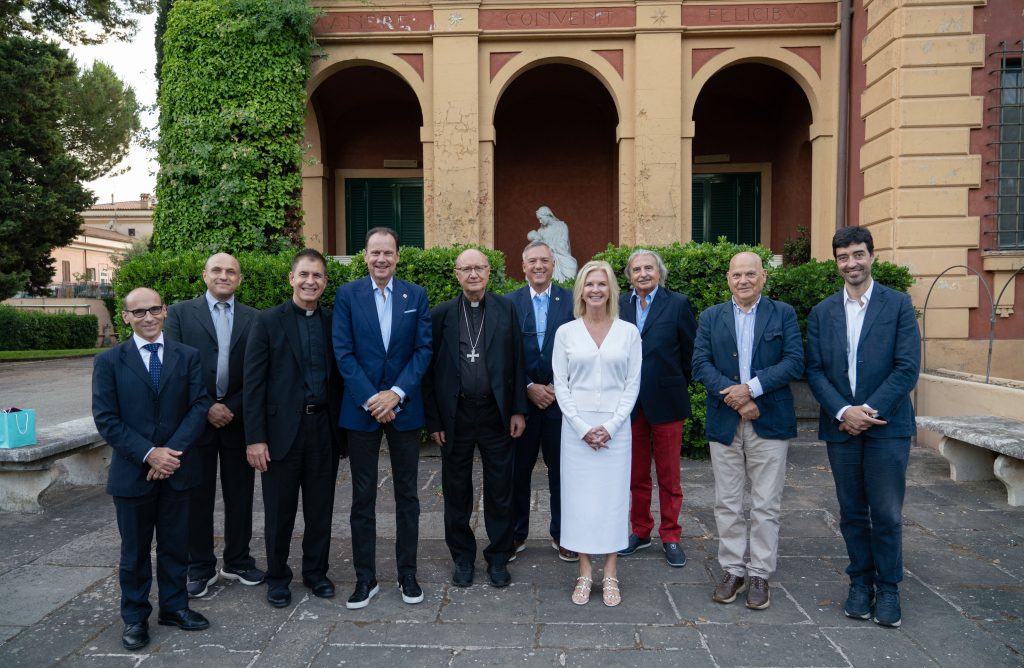
On a recent day in early March, construction crews were kicking off the second phase of the campus center renewal by starting to demolish the former entrance to the McGinley Center, the student hub that opened in 1959. Meanwhile, nearby, in a new four-story addition to that same McGinley Center, students were congregating in the student lounge—catching up, shooting pool, typing on their computers—and soaking in the soothing ambience.
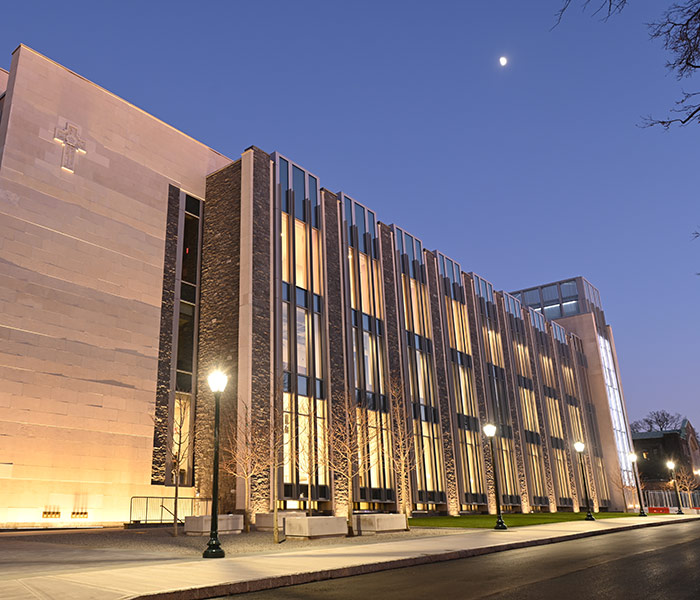
“It’s relaxing. I enjoy being here,” said Thomas Aiello, a junior who was getting some work done on his laptop. A student seated nearby, Kayla Bonitto, appreciated having the new gathering space after the physical isolation of taking virtual classes during the height of the pandemic. She and her friends had made plans to explore the new building together; on a recent night, students had gathered in the lounge for the State of the Union address and updates on the crisis in Ukraine. “It’s like a new sense of community,” she said.
That was the idea behind the campus center renewal, a keystone of the University’s $350 million fundraising campaign, Cura Personalis | For Every Fordham Student, which seeks to enhance all aspects of the student experience.
The new building addition will be combined with the Rose Hill Gym, Lombardi Center, and a renovated McGinley Center to form a larger complex that provides the entire University community with vastly greater space for offices, events, dining, fitness, and forming personal connections.
For some who have given in support of the project, it represents not just bricks and mortar but rather the continuous work of serving students and advancing the University from one era to the next.
Forging Ahead, Past the Pandemic
Kim B. Bepler, a Fordham trustee fellow and longtime University benefactor, recalled coming to campus for a lunch meeting during the first year of the pandemic, when the pivot to virtual learning had left the common areas of campus empty and quiet—except for the noise made by the builders.
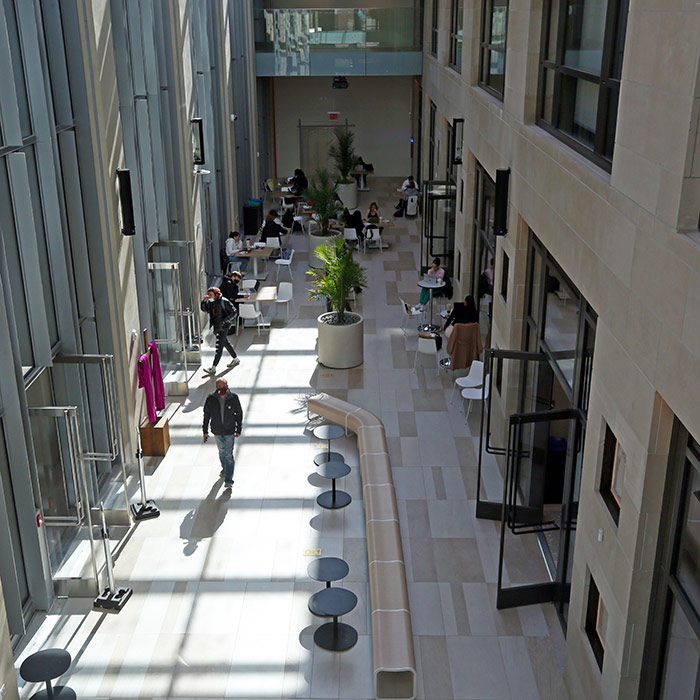
“It was rather poignant to be there when no one else was” and hear the project proceeding, she said. “At that moment, when we were all frightened, when we had no idea what was going on and when this was ever going to be over, that indicated to me that things would move on, life would continue somehow, some way,” she said.
She and her late husband, Steve Bepler, FCRH ’64, who passed away in 2016, have funded a wide array of needs at the University, including four endowed chairs in the STEM fields. It was appealing to support this project because the campus center will be named for Fordham’s president, Joseph M. McShane, S.J., and also because of its importance for fostering the informal exchange of ideas beyond the classroom, she said.
The project was important to Steve because of his own experience of student life at the University—“He loved his Fordham education,” she said.
“I just found that very encouraging and very heartwarming to be there during the pandemic and to listen to the sounds of construction and the sounds of the future,” she said.
‘Part of Being a Great University’
Trustee Emeritus Robert E. Campbell, GABELLI ’55, went to Fordham at a much different time, when the business school was housed in a surplus Army barracks building on the Rose Hill campus. “Many days, we would sit through class with our overcoats on,” he said. The McGinley Center wasn’t yet built, and because he was commuting from northern New Jersey, his mingling on campus was limited.
Even so, the social experience has stayed with him. “It put me in touch with so many new people,” he said. The Rose Hill campus “always was a place where wonderful people congregated.”
He went on to contribute to the physical transformation of the campus—as chair of the Board of Trustees from 1992 to 1998, he played a leadership role in the construction of the William D. Walsh Family Library, which opened in 1997. He and his wife, Joan M. Campbell, are generous University donors who were among those honored with the naming of the residence hall complex—comprising Campbell Hall and Salice and Conley Hall—that opened at Rose Hill in 2009.Now, they are giving in support of the campus center renovation and expansion.
“I don’t look at it as necessarily just a physical structure,” Campbell said. “It’s a home for people. People come to Fordham and leave their own homes [and]take up residence at a place. My feeling has always been that you would like to make that, physically, as supportive as possible.”
He noted that students’ experience of the new campus center could encourage them to give back to the University down the line.
“You always have to keep investing. It’s just part of being a great university, which Fordham is,” he said.
Communal Spaces
The new campus center offers state-of-the-art fitness equipment; glass walls and ceilings that allow for natural light; bigger and better spaces for the Career Center, Campus Ministry, and Center for Community Engaged Learning; new multipurpose rooms; and many other amenities.
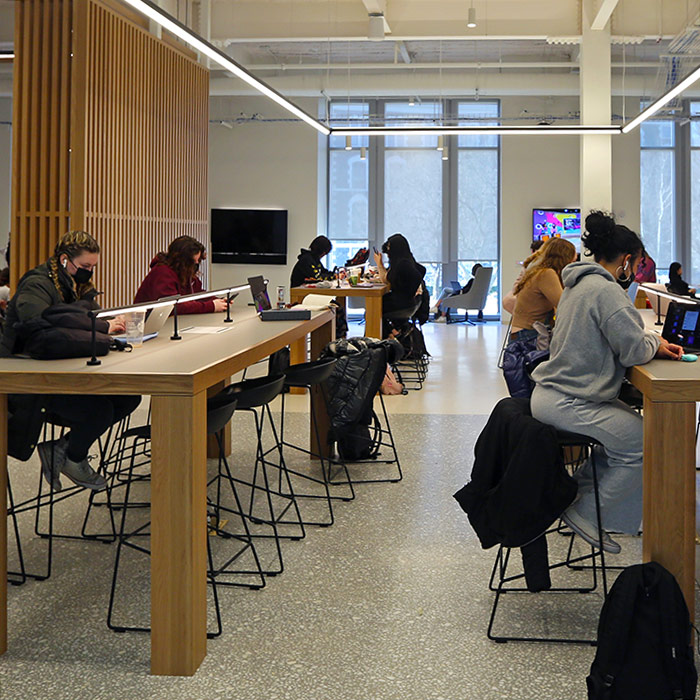
And more is yet to come—the phase-two demolition of the current McGinley Center entrance is clearing the way for an enclosed glass arcade from which students can access the Rose Hill Gym, the McGinley Center, the Lombardi Center, and the new building. That’s expected to be done by September 2023, said John Spaccarelli, director of facilities and special projects, who is overseeing the construction.
Phase three, to be done by the end of 2024, involves renovating the McGinley Center and reconfiguring some of its existing spaces, Spaccarelli said. He estimated that the entire campus center renewal is 35% to 40% complete.
In the student lounge, first-year student Jocelyn De Fex appreciated having the kind of inviting communal space that commuters like herself would otherwise have a hard time finding on campus. “If this didn’t exist, I would only be able to go to the library,” she said. She was hanging out and eating breakfast in the lounge with Kayla Bonitto, who appreciated the layout that makes the Career Center easier to find.
“When you get off the [second floor]elevator, it’s immediately right there,” said Bonitto, a junior.
A Place for Focusing
Nearby, Nick Chao, also a junior, said the lounge seemed to invite studying. “You kind of feel like when you come here, you can get work done,” he said. “I come here maybe a few times a week, maybe late at night, just to get some studying in.”
Conversation formed a gentle background hum. The 17-foot-high ceilings were treated with an acoustical spray that not only protects against fire but also dampens the sounds that would normally be bouncing around between the walls and the ceiling, Spaccarelli said.
Aiello, an organizer with the Herd, a student group supporting Fordham athletics, said the aesthetic appeal of the center will surely help with recruiting prospective students as well as student-athletes. The project shows Fordham’s commitment to updating its infrastructure, and “I think that’s huge for [the University],” he said.
To inquire about giving in support of the campus center renewal or another area of the University, please contact Michael Boyd, senior associate vice president for development and university relations, at 212-636-6525 or [email protected]. Learn more about Cura Personalis | For Every Fordham Student, our campaign to reinvest in every aspect of the Fordham student experience.
]]>
Thanks to the generosity of two dedicated donors, Fordham has just significantly strengthened its commitment to science education.
On Sept. 26, the University installed three accomplished scholars as new faculty chairs in the STEM fields: Silvia C. Finnemann, Ph.D., a Fordham biology professor whose research focuses on eye-cell function; Hans-Joachim Hein, Ph.D., a Fordham math professor who has earned international recognition for his geometry research, and Joshua A. Schrier, Ph.D., a chemistry professor and researcher who recently joined Fordham’s faculty from Haverford College. The three assumed the Kim B. and Stephen E. Bepler Chairs in Biology, Mathematics, and Chemistry, respectively.
“This evening’s ceremony and installation of the new Bepler STEM faculty chairs redefines what it means to study the sciences at Fordham,” said Frederick J. Wertz, Ph.D., interim dean of Fordham College at Lincoln Center.
The endowed professorships not only bolster Fordham’s commitment to the STEM fields—they also reshape the legacy of the donors who made them possible: the late Steve Bepler, FCRH ’64, and Kim Bepler.
“Kim and Steve’s dedication to advancing the sciences has and will continue to foster countless opportunities for future generations of talented Fordham students eager to transform the world in which we live,” said Wertz.

Maura Mast, Ph.D., dean of Fordham College at Rose Hill, said the couple were among “the most remarkably generous supporters the University has ever known.”
The chairs were funded using part of a $10.5 million gift made by Steve’s estate and Kim in July 2017. The gift also funded a chair in physics, which has yet to be filled.
A Salute to Kim and Steve Bepler
Fifty-four years ago, Steve Bepler graduated from Fordham College at Rose Hill. He rose to become senior vice president of Capital Research Global Investors, received an honorary doctorate from Fordham, and served as a University trustee. His widow, Kim, serves as a Fordham honorary trustee fellow.
“Kim Bepler has devoted much of her time to philanthropy since retiring in 2002 as director of business development at Cahners Travel Group,” said Mast. “The Beplers’ legacy and incredible impact on our students’ lives and education continues to thrive and live on through Kim.”
Joseph M. McShane, S.J., president of Fordham, said Kim shared Steve’s enthusiasm and at times, he said, “I think she was the person who sparked his enthusiasm.”
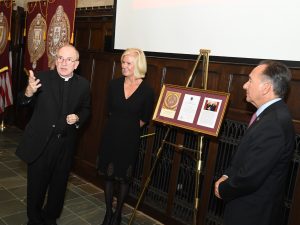
Together, the couple made many significant gifts that will benefit Fordham students for years to come. They established two other endowed chairs—one in theology, the other in poetics; created scholarships; helped restore the University Church; and supported several programs across the University. Next month marks two years since Steve’s untimely passing in 2016.
“I often teased Steve when he was alive that he was one of the few people who said a prayer for generosity, and God heard his prayer,” said Father McShane, to a round of laughter.
Kim said her husband was generous, but he shied away from the spotlight.
“He would have frankly taken great exception to naming the STEM chairs after him. So, Father, when you get to heaven, you have some explaining to do,” she said. The crowd chuckled.
Father McShane recounted a memory of Steve wandering through the Rose Hill bookstore. The clerk, wondering if he was the father of a student, asked if he needed help. Steve declined, but when he continued to meander, the clerk returned. “What are you doing?” he asked.
“Steve, with his disarming honesty, said, ‘Look, there are so many books I didn’t read when I was in college, I’m trying to make up for it now,’” Father McShane recalled. “He was not only a person who lived to be generous. He lived to learn.”
“May your lives, personal and professional, be marked by similar passions: passion for family, passion for education and the openness to discoveries every day,” Father McShane said, looking directly at the three honorees. “Live to be generous—with your talents, with your wisdom, with your love of learning.”
The Three Faculty Chairs
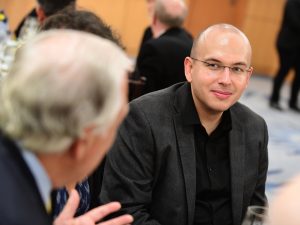
From eye health to quantum gravity to energy technology, the work of the new Bepler chairs spans several scientific disciplines.
Finnemann’s research has shed light on what causes blindness and how it can be prevented. Specifically, it focuses on the cell biology and diseases of the eye, particularly age-related macular degeneration—the most common cause of adult blindness in the United States. Her work has led to more than 50 publications in widely acclaimed international journals. At Fordham, she has helped the biology department obtain critical grant support from the National Institutes of Health, and she received the 2013 Fordham Award for Excellence in Teaching. She serves on the editorial board of Nature’s Scientific Reports and consults for the U.S. Department of Health and Human Services/NIH.
Hein’s research on quantum theories of gravity was published in the most selective journal in mathematics. He is one of the world’s leading experts on gravitational instantons—a key concept in quantum theories of gravity—and has earned international recognition for his research in differential geometry. Hein has held appointments at Imperial College London, the University of Nantes, the University of Maryland, and as of 2016, Fordham.
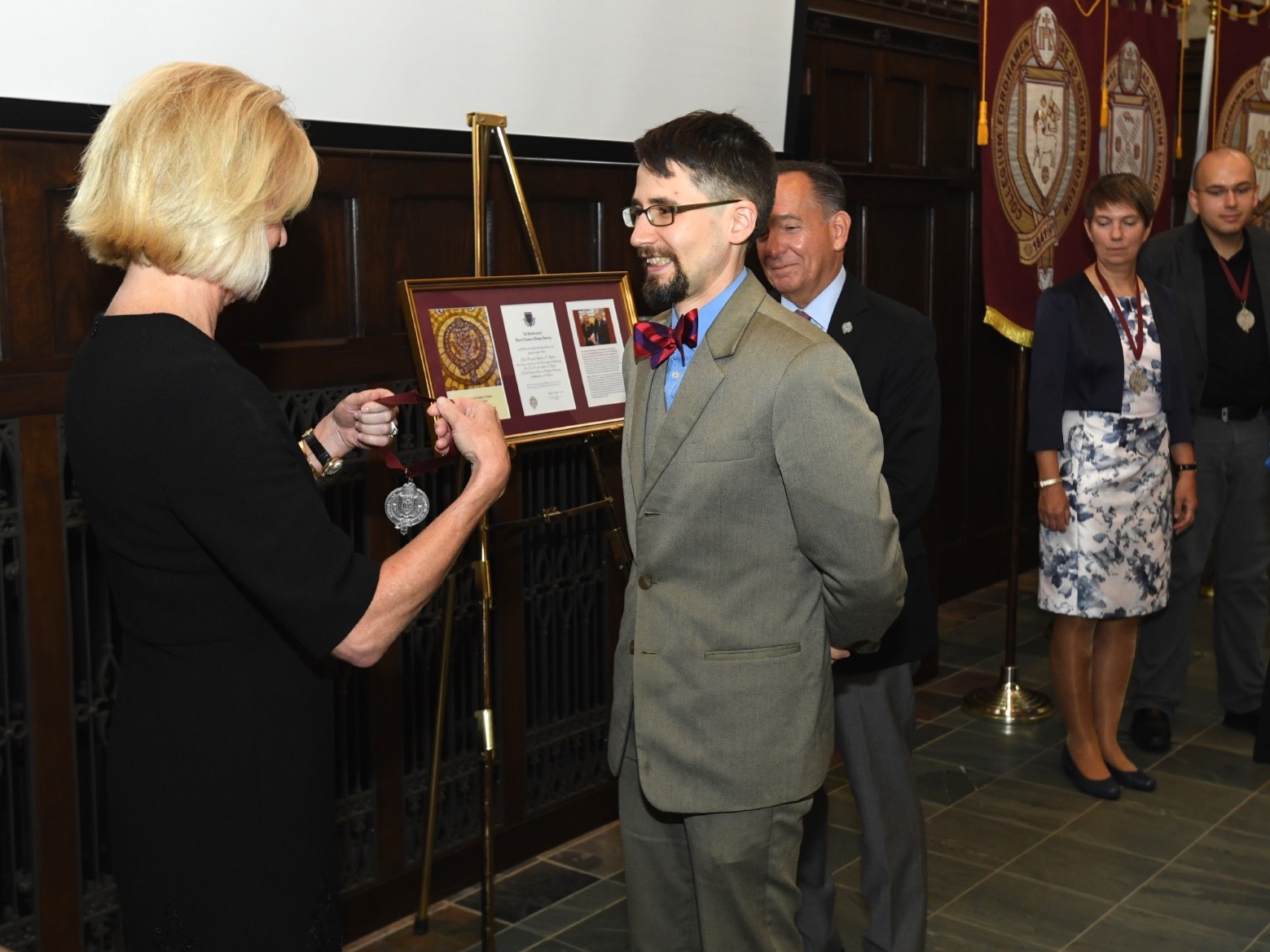
Schrier’s expertise is in the computational design of new materials in information and energy technology. He has authored 44 peer-reviewed papers and secured more than $8.6 million in external funding. Schrier was a Fulbright scholar at the Fritz Haber Institute of the Max Planck Society in Berlin and a Luis W. Alvarez postdoctoral fellow at the Lawrence Berkeley National Laboratory. This is his first year at Fordham.
After accepting their engraved medals, the three new chairs explained their research under the 47-foot-high sloped ceiling and stained-glass window of Tognino Hall. They used layman’s lingo and pictures: a purple cross-section of a human eye, a crumpled piece of graph paper that illustrated warped space, the iconic black-and-white shot of Albert Einstein sticking out his tongue, and robots with googly eyes.
Salma Youssef, FCRH ’20, the student speaker at the event, said that the new professorships enhanced math and science education at Fordham.

“Having access to such innovative, forward-thinking professors is a major reason why the STEM fields at Fordham are thriving and growing,” said Youssef, a George and Mary Jane McCartney Research Fellow. “Seeing faculty supported by Fordham donors like the Beplers is inspiring to all students like me who want to pursue academia and scientific research.”
Over the past 15 years, Fordham’s number of endowed chairs has more than tripled to reach 71, including the new Bepler chairs.
“Steve believed a world-class university should have a world-class science program,” Kim said. “We are on our way.”
]]>
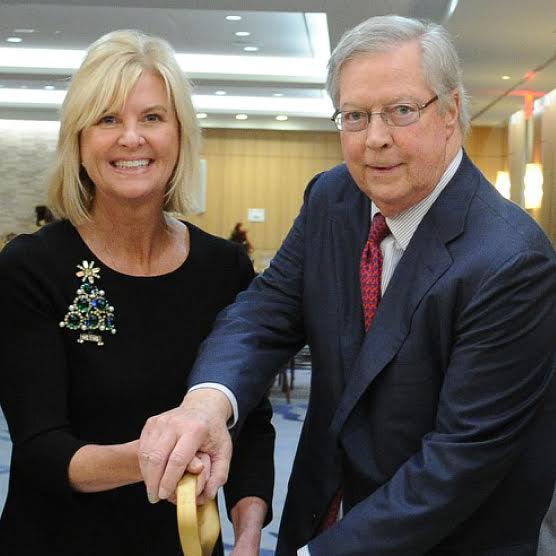
- The Kim and Steve Bepler Chair in Mathematics
- The Kim and Steve Bepler Chair in Physics
- The Kim and Steve Bepler Chair in Chemistry
- The Kim and Steve Bepler Chair in Biology
The additional $2.5 million will be added to a fund for a new science building to be built eventually at Fordham’s Rose Hill campus in the Bronx, to which the Beplers have already given $7.8 million.
“Steve was a true man of Fordham, and Kim has honored him and us with her ongoing passion for Fordham’s noble mission and involvement in the life of the University,” said Joseph M. McShane, S.J., president of Fordham. “We are truly grateful for Steve and Kim’s extraordinary generosity and care for Fordham. This gift will help educate generations of scholars in the Jesuit tradition, and is an investment in the sciences at Fordham.”
The University is seeing growth in STEM disciplines, including a rise in science majors, the newly launched Fordham Center for Cybersecurity (the National Security Agency and the Department of Homeland Security have designated Fordham as a National Center of Academic Excellence in Cyber Defense Education this spring), in addition to the University’s graduates traditionally high acceptance rates in U.S. medical schools.
At the time of Steve Bepler’s death, in October 2016, Robert D. Daleo, chair of Fordham’s Board of Trustees, said, “Steve Bepler was a trusted colleague and a very astute businessman. My heart goes out to Kim and his family on their great loss. Steve was generous with his time and gifts, and both genial and straightforward in his relations with his colleagues on the Board. I will miss his wisdom and his good company.”
Kim and Steve Bepler’s investment in Fordham’s mission is profound and far reaching, now totaling $31 million. Their gifts have created several other endowed professorships and scholarships, supported Fordham’s Catholic and Jesuit mission, and they have given generously to the Fordham Founder’s Scholarship Fund. Their generosity also had an impact on several Rose Hill buildings, including the University Church (and later a new organ), where the couple contributed toward its restoration. Two years ago, their philanthropy was recognized with the naming of Bepler Commons in Faber Hall. The Beplers are among the three largest donors to the University. Fordham honored the Beplers with the Fordham Founder’s Award in 2007, and in 2014, Steve Bepler was awarded the University’s highest honor, a Doctor of Humane Letters, at Fordham’s Commencement.
Steve Bepler worked as an investment professional for nearly five decades. After earning his M.B.A. at Columbia University School of Business in 1966, he began his career at Brown Brothers Harriman & Co. in the investment advisory department. He joined Capital Group in 1972 and remained there for four decades, rising to senior vice president and director at the company’s Capital Research Global Investors division. He also served as an equity portfolio manager at American Funds Washington Mutual Investors Fund, Capital World Growth and Income Fund, and EuroPacific Growth Fund. He and his EuroPacific Growth team were twice (1999 and 2009) recognized by Morningstar’s “Fund Manager of the Year” Awards in the international stock arena. In addition to his financial work, Bepler taught a course at Stanford University for more than a decade.
The Beplers were married in 2002. They gave generously to a variety of educational institutions and causes, including the Archdiocese of New York, New York Nativity Schools, and Cristo Rey New York High School in Harlem. Steve Bepler was also a benefactor and board member of the Forman School in Litchfield, Connecticut, Barnard College, the Inner-City Foundation, the Washington Theological Union in Washington, D.C., and Fairfield University in Connecticut.
“Like her late husband, Kim Bepler exemplifies the Jesuit principle of men and women for others,” said Father McShane. “We are pleased beyond words that she has embraced the community of students and scholars at Fordham. Her kindness and generosity will not only change the lives of students for generations to come, but also exhorts us to become better women and men in the service of the University.”
]]>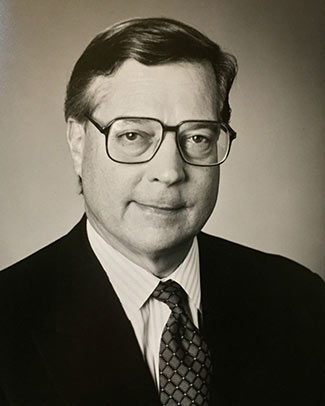
“We have lost one of the great ones today,” said Joseph M. McShane, S.J., president of Fordham. “He was so many things: a thoughtful and highly effective member of the Board of Trustees, a generous benefactor, and a dear friend. He was a man of great love and great integrity, and was singularly devoted to his family and the University. I know the Fordham family joins me in keeping his loved ones in their thoughts and prayers.”
Born in New York City on July 21, 1942, Bepler first encountered the Jesuits after his family moved to Seattle, Washington and joined a Jesuit parish, where he became an altar boy. That spiritual introduction grew into a lifelong intellectual relationship with the Jesuits that began at Seattle Preparatory School and culminated in a return to New York and enrollment at Fordham.
Two uncles and an elder brother, Peter, preceded him at the Rose Hill campus.
“They ask why on the important questions,” he once said of the Jesuits. “They’re willing to ask why, even if they don’t get the answers they want.”
At Fordham, Bepler worked six days a week, played intramural sports, and sang in the glee club, all while studying Greek and Latin. He graduated with a bachelor’s degree in classics.
Bepler’s career as an investment professional spanned nearly five decades. After earning his M.B.A. at Columbia University School of Business in 1966, he began his career at Brown Brothers Harriman & Co. in the investment advisory department. He joined Capital Group in 1972 and remained there for four decades, rising to senior vice president and director at the company’s Capital Research Global Investors division.He also held positions as an equity portfolio manager at American Funds Washington Mutual Investors Fund, Capital World Growth and Income Fund, and EuroPacific Growth Fund. He and his EuroPacific Growth team were twice (1999 and 2009) recognized by Morningstar’s “Fund Manager of the Year” Awards in the international stock arena. In addition to his financial work, Bepler taught a course at Stanford University for more than a decade.
“Throughout his 40-plus year career at Capital Group, Steve embodied our core values. He operated with the highest integrity, was a collaborative partner with his colleagues, and made all decisions with the investor in mind. I speak on behalf of many of our long-tenured colleagues and retirees, when I say that he will be missed,” said Tim Armour, chairman and chief executive officer of Capital Group.
“Steve Bepler was a trusted colleague and a very astute businessman,” said Robert Daleo, GABELLI ’72, chairman of the Fordham Board of Trustees. “My heart goes out to Kim and his family on their great loss. Steve was generous with his time and gifts, and both genial and straightforward in his relations with his colleagues on the Board. I will miss his wisdom and his good company.”
Bepler and his wife, Kim, were married 14 years ago. The couple gave generously to a variety of educational institutions and causes, including the Archdiocese of New York, New York Nativity Schools, and Cristo Rey New York High School in Harlem. Bepler was also a benefactor and board member of the Forman School in Litchfield, Connecticut, Barnard College, the Inner-City Foundation, the Washington Theological Union in Washington, D.C., and Fairfield University in Connecticut. Bepler had struck up a friendship with Fairfield’s president, Jeffrey von Arx, S.J., when Father von Arx was the dean of Fordham College at Rose Hill.
Bepler held several leadership positions during his tenure on Fordham’s Board of Trustees, including chair of the Student Affairs Committee, vice chair of the Mission and Identity Committee, and member of the Executive Committee. He also served as a trustee of Barnard College.
At Fordham, the couple created several scholarships, supported science education, and gave generously to the Fordham Fund. Their generosity also had an impact on several Rose Hill buildings, including the University Church, where the couple contributed toward its restoration. Two years ago, their philanthropy was recognized with the naming of Bepler Commons at Faber Hall. The Beplers are among the three largest donors to the University.
“Steve was a quiet and generous philanthropist,” said James Buckman, FCRH ’66, a member of the Fordham Board of Trustees. “While a leading benefactor of Fordham University and other Jesuit apostolic enterprises, one would rarely find his name associated with them. He preferred to endow a university chair in the name of a favorite Jesuit teacher than his own. He will be sorely missed.”
When the University honored the couple with the Fordham Founder’s Award in 2007, Kim, a successful businesswoman in her own right, spoke of her husband’s affinity for, and devotion to, his alma mater.
“I love my husband and his love of all things Fordham,” she said.
At the 2014 commencement ceremony, Bepler received the University’s highest honor: a Doctor of Humane Letters.
Throughout his life, Bepler credited the Jesuits with laying the groundwork for his success in life. He specifically honored the educators so dear to his heart by endowing two Fordham faculty chairs: the John D. Boyd, S.J., Chair in Poetic Imagination and the Karl Rahner, S.J., Memorial Chair in Theology.
Father Boyd, one of Bepler’s professors, was a distinguished scholar whose work focused on the poetic imagination and its relationship to life.
“His was the third class I ever took at Fordham,” Bepler said in 2009, speaking at an inaugural ceremony to launch the chair. “He loved to teach. He made everything interesting, which is such an important and rare quality in an educator.”
“His love of poetry was apparent both in our conversations and in his endowing a chair with the splendid tile, ‘Chair in the Poetic Imagination,’” said Heather Dubrow, Ph.D., the holder of the John D. Boyd, S.J. Chair in the Poetic Imagination at Fordham. “I will always be grateful to Stephen and Kim Bepler for enabling me to come to Fordham.”
As avid art and antique collectors, the couple traveled extensively throughout Europe and Asia.
In addition to his loving wife, Kim, Bepler is survived by three children from a previous marriage, Bettina, Peter, and Galen; his brother Peter, and sister, Cathy; and two grandchildren. He also leaves behind three dogs, to which he was devoted.
“We all come to this end point in our lives. But I have known preciously few who have spent willingly their entire lives in full conscious preparation for this moment,” said John Kehoe, FCRH ’60, FCLC ’85, a Fordham trustee. “Steve was such a rare person. His generosity of spirit in all things was as effusive as the quickness of his wry wit and humor. He treasured the gift of his early Jesuit education and, as a true disciple, labored to extend it to as many young people as he could in as many ways as he could find to do so, right to the end of his life. Because of that, and of his wife, Kim, having shared fully in that journey, his work and spirit will continue to live and be remembered long into the future.”
]]>